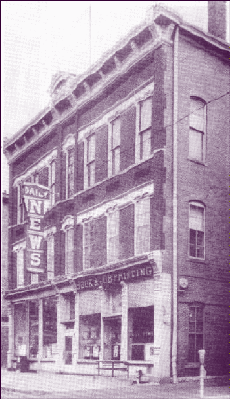
About UsThe Numismatic Bibliomania Society is a non-profit association devoted to the study and enjoyment of numismatic literature. For more information please see our web site at coinbooks.org SubscriptionsThose wishing to become new E-Sylum subscribers (or wishing to Unsubscribe) can go to the following web page link MembershipThere is a membership application available on the web site Membership Application To join, print the application and return it with your check to the address printed on the application. Print/Digital membership is $40 to addresses in the U.S., and $60 elsewhere. A digital-only membership is available for $25. For those without web access, write to: Charles Heck, Treasurer
AsylumFor Asylum mailing address changes and other membership questions, contact Terry at this email address: terrywhite5475@yahoo.com SubmissionsTo submit items for publication in The E-Sylum, write to the Editor at this address: whomren@gmail.com BUY THE BOOK BEFORE THE COINSale Calendar |
- WAYNE'S WORDS: THE E-SYLUM JULY 10, 2019
- KOLBE & FANNING SALE 153 CLOSES JULY 13, 2019
- NEW BOOK: COINS OF NEUCHATEL, SWITZERLAND
- NEW BOOK: BRITISH GALLANTRY AWARDS POCKET GUIDE
- THE IMPORTANCE OF GOOD RESEARCH AND WRITING
- THE LIMITS OF INTERNET RESEARCH
- CHAPMAN BROTHERS CORRESPONDENCE AT ANS
- VIDEO: BANK NOTE COLLECTOR ORGANIZATIONS
- THE WAR NICKEL KING OF NEW YORK
- NEW YORK CITY NUMISMATIC TOURS
- THE PAPER EMERGENCY COINS OF LEIDEN
- NOTES FROM E-SYLUM READERS: JULY 7, 2019
- ARTICLE HIGHLIGHTS JAMES BAILEY'S COIN FINDS
- NEW BANK OF ENGLAND MUSEUM EXHIBIT
- VOCABULARY TERMS: CLAD, CLADDING
- THEODORE JOSEPH VENN (1860-1936)
- BENEFITS OF THE 2019-W QUARTERS PROGRAM
- AUDIO: MATT ROTHERT SR.
- SUNDMAN LECTURES AT THE AUGUST 2019 ANA
- MONEY TALKS AT THE AUGUST 2019 ANA
- THE RICHMOND COLLECTION SALE
- THE LEGEND NUMISMATIC AUCTION BUSINESS
- SELECTIONS FROM JULY 2019 EARLY AMERICAN SALE
- SELECTIONS FROM HOLABIRD JULY 2019 SALES
- THEODOSIUS II SOLIDUS FOUND BY ISRAELI STUDENTS
- SWIPING THE MILLION-DOLLAR GOLD COIN
- NEW NICARAGUAN POLYMER BANKNOTES
- WEST AFRICAN STATES SEEK COMMON CURRENCY
- KID COUNTERFEITERS?
- LOOSE CHANGE: JULY 7, 2019
- $100 BILL TOOTHPICK TRICK
- FEATURED WEB SITE: NAVONA NUMISMATICS
Click here to access the complete archive
To comment or submit articles, reply to whomren@gmail.com
Content presented in The E-Sylum is not necessarily researched or independently fact-checked, and views expressed do not necessarily represent those of the Numismatic Bibliomania Society.
WAYNE'S WORDS: THE E-SYLUM JULY 10, 2019
 Many thanks to readers who
sent Fourth of July wishes. This week is a two-fer issue: we open with two new books, two articles on careful numismatic research, two updates from the Newman
Numismatic Portal, and two articles relating to numismatics in New York City.
Many thanks to readers who
sent Fourth of July wishes. This week is a two-fer issue: we open with two new books, two articles on careful numismatic research, two updates from the Newman
Numismatic Portal, and two articles relating to numismatics in New York City.
Other topics this week include paper siege coins, Arabian silver coins found in New England, authors Theodore Venn, Matt Rothert and Dennis Tucker, benefits of the 2019-W quarter program, educational talks at the 2019 ANA World's Fair of Money, Nicaraguan banknotes, kid counterfeiters and a $100 bill toothpick trick.
To learn more about coins of Western Switzerland, British Gallantry Awards, the War Nickel King of New York, the number of 1894-S dines, Royal Mint coin designer Joseph Boehm, Jacobite banknotes, The Richmond Collection, the Parsons gold ingots, "Daddy Dollars", Barton's metal and explosion bonding, read on. Have a great week, everyone!
Wayne Homren
Editor, The E-Sylum
KOLBE & FANNING SALE 153 CLOSES JULY 13, 2019
Don't forget! Kolbe & Fanning's numismatic literature sale #153 is closing Saturday, July 13, 2019. Get your bids in! -Editor
FINAL REMINDER OF KOLBE & FANNING’S JULY 13 BOOK AUCTION
 Kolbe & Fanning Numismatic Booksellers will hold our Sale 153 this Saturday, July 13, 2019, beginning at
12:00 noon eastern time. The sale includes a fine selection of books on ancient, world and U.S. numismatics, with especially important offerings from the
library of Philip J. Carrigan. The 500-lot sale features core references on ancient and world coins, many of them in fine bindings, as well as particularly
notable runs of American auction catalogues. The sale may be viewed at bid.numislit.com .
Kolbe & Fanning Numismatic Booksellers will hold our Sale 153 this Saturday, July 13, 2019, beginning at
12:00 noon eastern time. The sale includes a fine selection of books on ancient, world and U.S. numismatics, with especially important offerings from the
library of Philip J. Carrigan. The 500-lot sale features core references on ancient and world coins, many of them in fine bindings, as well as particularly
notable runs of American auction catalogues. The sale may be viewed at bid.numislit.com .
Bids may be placed via post, email, fax or phone, as well as online. Bids placed via post, email, fax or phone must be received by Friday, July 12, the day before the sale, in order for them to be processed. Kolbe & Fanning uses Auction Mobility as our third-party online bidding platform. Auction Mobility is an app-based platform allowing users the ability to participate in the sale through phones, tablets and computers. To register for the sale, bidders must go to bid.numislit.com and sign up. Once you have set up an account, you may browse lots, place advance bids, or participate in the live sale online. Those wishing to participate on their devices can download the Kolbe & Fanning app through the Apple or Google Play Store.
Advance absentee bids may also be placed online at bid.numislit.com; live internet bidding will be available during the sale itself through the same platform. Bidders placing absentee bids will be able to tell immediately whether or not they have the current high bid. Bidders will also receive email notifications when they are outbid before the sale (users of the app may receive push notifications as well).
Kolbe & Fanning Numismatic Booksellers LLC is a licensed and bonded auction firm in the State of Ohio. For more information, please see the Kolbe & Fanning website at numislit.com or email David Fanning at df@numislit.com. To register for the sale, go to bid.numislit.com. We look forward to your participation on July 13.
NEW BOOK: COINS OF NEUCHATEL, SWITZERLAND
This new French language publication by Charles Froidevaux covers in detail the coins of the Neuchâtel region of Switzerland. The title translates to Economic and Monetary History of Western Switzerland. Here's a Google-translated version of the book description from the publisher's web site. An article by Ursula Kampmann in the July 4, 2019 issue of CoinsWeekly alerted me to the book - thank you. -Editor
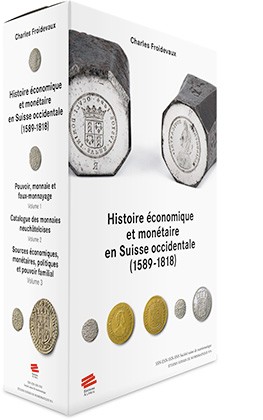 With this three-volume work, Charles
Froidevaux presents a monetary history of Western Switzerland and a catalog of Neuchâtel coins.
With this three-volume work, Charles
Froidevaux presents a monetary history of Western Switzerland and a catalog of Neuchâtel coins.
The first volume proposes a monetary history of Western Switzerland. This study is located at the crossroads of several fields: history, the history of economic thought, the history of currency crises and the counterfeiting of money-laundering issues that ensue in Berne, Basel, Neuchâtel and Geneva, numismatics, statistics, metrology and genealogy. In addition to presenting a global monetary history of Western Switzerland over several centuries, the book is also a kind of encyclopedia and gives tools to understand the monetary history, currency crises, devaluations, equivalences between different currencies - notably with the Kingdom of France - as well as the relations between the currencies of the states of Western Switzerland. For the first time, an analysis of the Romagna currency (Romandie) is formulated. Currency of account, it allowed to synchronize the currencies between the French-speaking regions and those of German language of the western part of the Swiss Corps. The second volume is a key catalog of Neuchâtel coins, both for numismatic researchers and for collectors. For each Neuchâtel coin, it offers a presentation according to the current standards of numismatics.
The coins are inventoried according to the collection in which they are kept, with inventory number, provenance, size and weight if they are available. Private collections are separated from public collections to allow collectors to assess the rarity of variants and their potential for market entry. A table of correspondences between the references of the work of Wavre, Demole and Montandon published in 1939 and those of this catalog allows museums and collectors to update their inventory.
The third volume is devoted to the sources, the documentary bases and the detailed analysis of the elements presented in the first two. The essential documents mentioned in the first volume or in the catalog are transcribed or photographed. The author has compiled genealogical tables, several documents on counterfeiting (including correspondence involving members of the Neuchâtel Council of State) and on the consequences of monetary conferences, under the Ancien Regime, for the various states of France. the western part of the Helvetic Corps. The techniques of reading ancient monetary documents are developed, as well as the transcription of abbreviations and the manner of deciphering the mandates displaying the prices of species in the western part of the Swiss Corps. The reader will also find an introduction to coin-making techniques and the role of master coiners and engravers, as well as the production accounts and production volumes of the Neuchâtel workshop. The last part of the volume analyzes the relations between the counterfeiting industry and the families in power in Neuchâtel
Author: CHARLES FROIDEVAUX
Title: Histoire économique et monétaire en Suisse occidentale (1589-1818)
Pages: 956
ISBN: 978-2-88930-275-8
Price: 99.00 CHF, 89.00 €, 119.00 $
For more information (in French), or to order, see:
Histoire économique et monétaire en Suisse occidentale (1589-1818)
(https://www.alphil.com/index.php/auteurs/froidevaux-charles/histoire-economique-et-monetaire-en-suisse-occidentale-1589-1818.html?___store=en_chf&___from_store=fr_chf)
To read the complete CoinsWeekly article (in English), see:
Everything There Is To Say About the Coins of Neuchâtel
(https://coinsweekly.com/everything-there-is-to-say-about-the-coins-of-neuchatel/)
NEW BOOK: BRITISH GALLANTRY AWARDS POCKET GUIDE
Spink has published a new pocket guide to British Gallantry Awards. Here's the information from their web site. -Editor
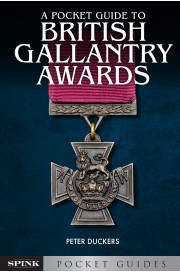 Over the ages and in all societies, gallantry in battle has been highly regarded, with the bravery of
individuals and fighting forces being officially rewarded and publically recognised in a wide variety of ways, such as gifts of jewels or money, grants of
land, promotions in rank or status etc.
Over the ages and in all societies, gallantry in battle has been highly regarded, with the bravery of
individuals and fighting forces being officially rewarded and publically recognised in a wide variety of ways, such as gifts of jewels or money, grants of
land, promotions in rank or status etc.
In Britain, it has been the practice since at least the mid-19C to award decorations – medals specifically conferred to reward bravery in action. With the growth of the British Empire in the late 19C, the waging of two World Wars, the campaigns that mark the end of Empire and a continuing UN and NATO role, Britain has produced a wide range of medals to reflect the gallantry of its own and Imperial fighting forces. Such rewards have been conferred upon men and women, in all theatres of war and amongst the whole range of its forces on the ground, in and under the sea, in the air and even “at home”.
This new Spink book offers an introductory guide to British and Imperial medals for gallantry which have appeared since 1854 and which continue to be awarded to this day, illustrating the type of action which has led to the award of the various medals over nearly 200 years.
A Pocket Guide to British Gallantry Awards
by Peter Duckers
176pp
ISBN: 978-1-912667-02-4
£25.00
For more information, or to order, see:
A Pocket Guide to British Gallantry Awards by Peter Duckers
(https://spinkbooks.com/index.php?route=product/product&path=76&product_id=636)

THE IMPORTANCE OF GOOD RESEARCH AND WRITING
Author and publisher Dennis Tucker of Whitman Publishing makes a great case for an orientation for detail in numismatic research and writing in an article published July 1, 2019 on Coin Update. Here's an excerpt, but be sure to see the complete article online. It's a must-read for anyone working on a numismatic manuscript. -Editor
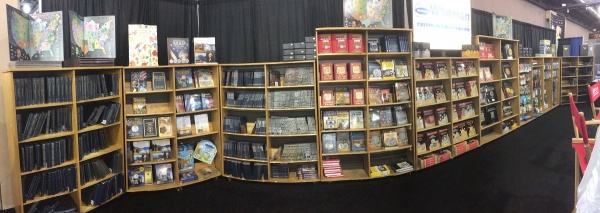
Coin books at the Whitman booth
In March 2019 Whitman publisher Dennis Tucker spoke about writing and research to eighth-grade students of Meadow Glen Middle School (Lexington, South Carolina). This is a transcript of that lecture.
Hello. My name is Dennis Tucker. I’m a professional writer and editor, which means I get paid to do the things you’re studying and practicing in school.
Since 2004 I’ve been the publisher at Whitman Publishing, a company that produces books mostly in the fields of history and antiques-and-Collectibles. Many of our books involve numismatics, which is the study of coins, tokens, medals, and paper money. This touches on history, art, technology, industry, mining, banking and economics, metallurgy, geography, and many related subjects.
I’ve been a coin collector since I was about seven years old. So not only do I get to help create books, which is something I love to do, but I get to work in what is essentially my lifelong hobby.
My general advice to writers is to know your subject matter; know your audience, and know your strengths and weaknesses as a communicator.
Take your research and writing seriously, but don’t take yourself too seriously. By that I mean
- be humble,
- always be a student—in other words, always think of yourself as someone who is learning, and
- have fun with your work.
Being a good communicator is an important skill. It always has been. It always will be. Good communication is useful, and valuable, in every field of human endeavor. I mention this not only because of the importance of sharing thoughts and ideas between people, but also because, on an individual level, being a good communicator will open up career opportunities for you.
If you’re writing nonfiction, your reputation as a researcher and author will depend on the integrity of your work. Are you accurate? Are you precise? When you go beyond reporting facts and you draw conclusions, are they based on reliable sources and careful reasoning? Can your readers trust you as an authority on your subject?
Often in research, primary sources will be your best friend. That means going to contemporary newspapers and government documents, letters and diaries, autobiographies, interviews, and the like.
Of course, keep in mind that primary sources can be colored by personal perspectives and biases, or they might contain mistakes. So don’t depend completely on any one primary source. Gather information from as many as you can. If you find discrepancies, look for reasons why.
If you ever find missing pieces in the puzzle of your research, resist the temptation to fill in the blanks with speculation. Or—if you must speculate, and you present a hypothesis or an undocumented possibility, keep these three things in mind:
- base your reasoning on as much historical evidence as you can,
- explain your thought process to your reader, and
- make it clear that what you’re writing is speculative.
Let me give you three case studies on the importance of research. The first is about a researcher whose groundbreaking work was marred by a strange weakness; the second is about a young writer, not much older than you, who solved a 200-year-old mystery; and the third is an example of a primary-source document that had some hidden traps.

Well put. I doubt I or anyone could frame the argument better. The case studies are short and each clearly highlights an important point. Be sure to read the complete article online. -Editor
To read the complete article, see:
The importance of good research and writing
(http://news.coinupdate.com/the-importance-of-good-research-and-writing/)
THE LIMITS OF INTERNET RESEARCH
On a related topic, Pat Heller published a July 4, 2019 article about the limits of internet research. This should be painfully obvious, but even highly rated and thoroughly written web pages might not be answering the question you're asking. -Editor
The Internet is a wonderful research tool but the content is not always accurate or complete. Therefore, one needs to temper the results of a numismatic search by confirming information from other sources or thinking about what holes may exist in what is discovered.
Here’s an example. Last week, I posted on my company’s Facebook page, and also my personal page, a question of who are the six identified (my mistake, there are actually seven) people other than Christopher Columbus who are depicted on US currency issues that were not born in what is now part of the United States of America.
These posts drew more attention and responses than usual. One respondent found a helpful website here and thought that the 53 people listed there included every specific person portrayed on US currency.
Using this website, however, only picked up four of the six people—Albert Gallatin from Geneva Switzerland, Alexander Hamilton from Charlestown, Saint Kitts and Nevis, George Meade from Cadiz Spain, and Robert Morris from Liverpool, England.
What did the site miss? Check out the article to find out. Who are the other three people? Can anyone think of any more? -Editor
To read the complete article, see:
The Limits Of Online Numismatic Research
(https://www.numismaticnews.net/article/the-limits-of-online-numismatic-research)
CHAPMAN BROTHERS CORRESPONDENCE AT ANS
The latest addition to the Newman Numismatic Portal is an archive of Chapman Brothers correspondence from the American Numismatic Society collection. Project Coordinator Len Augsburger provided the following report. -Editor
Chapman Brothers Correspondence at the American Numismatic Society
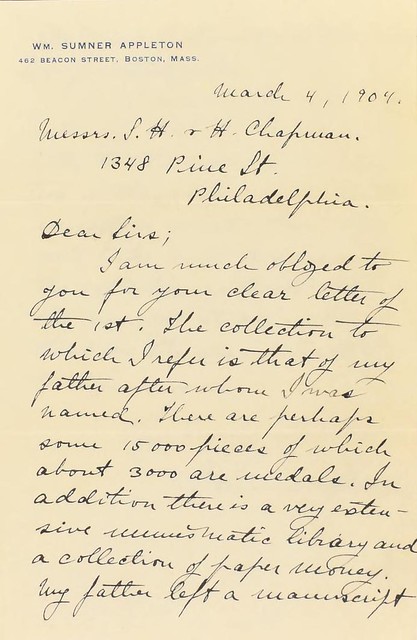 The ANS acquired a
sizable group (19 boxes) of Chapman brothers archives, c. 2000, related to business activities of this Philadelphia rare coin firm at the turn of the 20th
century. Handling some of the most important collections of the period, beginning with the Bushnell sale in 1882, the Chapmans did much to define the practice
of auction cataloging. Descriptions grew less terse, and the usage of photography increased. “Deluxe” editions signaled the numismatic community that it was
perfectly acceptable to collect books. Today their sale catalogs are avidly collected. The Chapman archives at the ANS include correspondence with the most
advanced collectors of the day, and reveal tidbits found nowhere else.
The ANS acquired a
sizable group (19 boxes) of Chapman brothers archives, c. 2000, related to business activities of this Philadelphia rare coin firm at the turn of the 20th
century. Handling some of the most important collections of the period, beginning with the Bushnell sale in 1882, the Chapmans did much to define the practice
of auction cataloging. Descriptions grew less terse, and the usage of photography increased. “Deluxe” editions signaled the numismatic community that it was
perfectly acceptable to collect books. Today their sale catalogs are avidly collected. The Chapman archives at the ANS include correspondence with the most
advanced collectors of the day, and reveal tidbits found nowhere else.
The Newman Numismatic Portal is sponsoring the scanning of the Chapman correspondence, which is expected to take several months. Scanning will proceed alphabetically by correspondent last name and appear online as it is scanned. “A” correspondents have started to populate, with one item of interest being the Appleton file. This contains 1904 correspondence between William Sumner Appleton, Jr. and the Chapmans, discussing the estate of Appleton, Sr. (1840-1903).
Some thought was given to consigning the material (15,000 pieces including 3,000 medals) to the Chapmans. In the end no arrangement was concluded with the two brothers, and the material went to the Massachusetts Historical Society (MHS), and also appeared at other dealer sales (Steigerwalt 5/1907, 1/1910, Elder 5/1913, 10/1913, and finally from MHS to Stack’s 5/1973). One can only imagine that Appleton might today be more widely known had the Chapmans presented the entire collection in a unified group of sales.
Image: William Sumner Appleton, Jr. correspondence to Samuel Hudson and Henry Chapman, March 4, 1904.
Link to Chapman Brothers correspondence on Internet Archive:
https://archive.org/details/americannumismaticsociety?and%5B%5D=ANS+Chapman+brothers&sin=&sort=-publicdate
I'm sure the Brothers Chapman never foresaw such a future use of their business correspondence files, but what a boon to numismatic researchers this will be! -Editor

VIDEO: BANK NOTE COLLECTOR ORGANIZATIONS
These are selections from the David Lisot Video Library that feature news and personalities from the world of coin collecting. David has been attending coin conventions since 1972 and began videotaping in 1985. In 2017 the Newman Numismatic Portal reached an agreement to list all David’s videos on their website. Each week an excerpt of a different video is available on the CoinTelevision YouTube channel.
Here's one on two banknote collector organizations, IBNS and SPMC. -Editor

Collectors of paper money have two great organizations to choose to learn more about their hobby, the International Bank Note Society and the Society of Paper Money Collectors. Both have scholarly journals and offer a place to share research. Best of all collectors can meet other people who share the same passion for paper money.
This video is a highlight from International Paper Money Show. The IPMS has non-stop action for those who collect, investigate, buy, sell, and trade paper money and banknotes of the world. Participants can see world class competitive exhibits and attend lectures sponsored by the major bank note organizations delivered by the best researchers in the paper money industry. If you want to talk paper money you need to come to the IPMS!
The entire interview is available on the Newman Numismatic Portal at:
https://nnp.wustl.edu/library/multimediadetail/522852
An excerpt of the video is available for viewing on the Coin Television YouTube Channel at:
https://youtu.be/Bukgn2AQsAI
Organizations to Benefit Bank Note Collectors Attend International Paper Money Show
VIDEO: 3:20
Robin Hill, International Bank Note Society, Mark Anderson, Society of Paper Money Collectors, David Lisot, Video Producer, CoinTelevision.com.
THE WAR NICKEL KING OF NEW YORK
Paul Bosco writes:
 Regarding the removal of 35% silver 5-cent pieces, I find this story about a sorting machine used at the mints to be
barely believable, although why would anyone make it up?
Regarding the removal of 35% silver 5-cent pieces, I find this story about a sorting machine used at the mints to be
barely believable, although why would anyone make it up?
In 1964-65, as a 9th grader, I was allowed to go to the bank at lunch-time, so I could get rolls of nickels. I removed dated buffaloes and warnicks, in roughly equal numbers, eventually sending maybe 20 rolls to someone with a buy ad in Coin World. SEVEN cents each. Postage was pretty nominal, then.
I doubt my profit approached minimum wage (then $1.25), having only about $10 capital. I also did better when babysitting, but that was hardly a hobby. In truth, at 14, I was probably a better Marxist than capitalist, but the point is, there were plenty of 1942-45-dated 35% silver "warnicks" in circulation, 20 to 23 years after their issuance. 1943 cents, too.
What the government clearly worked to remove from circulation was National Bank Notes ("brown seals"), which was done effectively.
In the 1980s I picked up a new customer, a very successful NYC tobacconist named Mark. He collected engraved and enameled coins, but his #1 and #2 collections were cigar store Indians and carousel animals. He had a couple dozen of each, IN HIS MANHATTAN APARTMENT!!!
After I knew him for years he mentioned that as a teenager he was the War Nickel King of New York. (He had much more capital than I.) This was probably 1960-64, in the heydey of the semi-monthly(!) Rosenbaum show. In the 1990s I mentioned this to Sam Sloat, who remembered "that kid." "We'd put the bags in the car trunk and drive back to Connecticut with the front bumper so high, we looked like a space ship."
This kind of coin removal has more to do with pathology than profit. People go thru rolls & bags of coins for fun, and few would tell you it pays like any day job. I was reminded of this last week, when a perfectly sane gent, with an entrepreneurial personal history, dropped 1) in at my store, and 2) nearly $1000 -- on wheat cents.
What actually did make financial sense was separating out 90% silver coins from clad coins. The increased examination of coins by the general public must have led to the effective removal of war nickels from the collective American pocket. There are still many 40% silver halves to be found in rolls, and maybe, with keen organizational skills, you can make $3-5 an hour plucking them out.
Great story! I hadn't heard of the War Nickel King. Even at seven cents apiece, that's a 40% gain on investment (minus the investment of time and postage, of course). Warren Buffet would kill for a margin that high.
As for the mint removing the coins, as Dave Lange pointed out, while there may have been a brief attempt to remove them, the effort must have been fairly quickly abandoned when it was realized to be unnecessary from the standpoint of the usability of the coins. Of course, this set the stage for later collectors and entrepreneurs like the War Nickel King to make that effort as silver prices advanced, making it profitable. -Editor
To read the earlier E-Sylum article, see:
SORTING SILVER NICKELS AT THE U.S. MINTS
(https://www.coinbooks.org/v22/esylum_v22n26a24.html)
NEW YORK CITY NUMISMATIC TOURS
Last week I asked "[What buildings] would be ripe for inclusion in a future numismatic tour of New York City[?] Besides the obvious places like the American Numismatic Society and major coin shops, what other interesting places might be worth seeing on such a tour?" -Editor
Max Hensley writes:
"Federal Reserve Museum, ANS holdings and library, American Bank Note Company structure (street view, company is gone), Stacks and other dealers, Museum of American Finance when they reopen."
To read the earlier E-Sylum article, see:
NOTES FROM E-SYLUM READERS: JUNE 30, 2019 : Mr. 880's House Today
(https://www.coinbooks.org/v22/esylum_v22n26a16.html)
Most of those are the usual candidates, but the facade of the American Bank Note Company building might be interesting. I'm surprised no one mentioned ANS Chief Curator Dr. Peter van Alfen's Numismatic Walking Tour of Lower Manhattan held July 14, 2018. I was unable to attend, but it sounded fun: "... as part of the ANS Summer Seminar, a walking tour that vividly illustrates the many connections between numismatic and medallic art of 20th century and the architectural and free standing sculpture found throughout lower Manhattan." -Editor
To read the earlier E-Sylum article, see:
NUMISMATIC WALKING TOUR OF LOWER MANHATTAN
(https://www.coinbooks.org/v21/esylum_v21n22a30.html)
I caught up with Peter via email in Antalya, Turkey, where he's giving a seminar this week at Koç University’s AKMED center. -Editor
Peter writes:
"Every year as part of the ANS’s seminar, I’ve given a numismatics oriented walking tour of lower Manhattan that I call Monuments, Medals, Metropolis that ends in Staten Island’s St. George historic district for a barbecue in my back yard.
"This year’s tour on July 19th is just for the students, I’m afraid. Even so, this year we will be experimenting with creating an online version of the tour, either as a sort of virtual tour or as something that folks can self-guide if they happen to be in town."
Peter kindly forwarded a tour handout. It's too lengthy to republish here, but we'll look forward to a future version online. Here's an excerpt for flavor. Stops include City Hall Park, the Telephone Building at 195 Broadway, Nassau Street offices of U.S. Mint envravers Brenner, Laubenheimer, and Paquet, the Federal Reserve Bank of New York, the Chamber of Commerce, Trinity Church, the New York Stock Exchange, Federal Hall, Battery Park, and the Alexander Hamilton Custom House. -Editor
This walking tour is meant primarily to highlight the art and architecture of lower Manhattan of the period between roughly 1900 and 1930, when artists and architects frequently worked in close association with one another as never before, and the connections between many of these artists and contemporary numismatic art. At the same time, we will also consider the history of New York City more broadly.
Much of what we will be looking at was created when the City Beautiful movement had captured the imagination of architects, artists, politicians, and other elites. The City Beautiful movement was a Progressive reform movement in North American architecture and urban planning that flourished in the 1890s and early 1900s with the intent of using beautification and monumental grandeur in cities to counteract the perceived moral decay of poverty-stricken urban environments. The movement did not seek beauty for its own sake, but rather as a social control device for creating moral and civic virtue among urban populations. Advocates of the movement believed that such beautification could thus provide a harmonious social order that would improve the lives of the inner-city poor.
Many of the same artists who were involved in the City Beautiful movement in New York City, producing both architectural and free standing sculpture, were also involved in President Theodore Roosevelt’s attempt to beautify US coinage. Roosevelt worked closely with Augustus Saint-Gaudens, one of the most preeminent sculptors in the US, to produce a new set of gold coins introduced in 1907, the year Saint-Gaudens died. Soon thereafter several of Saint-Gaudens’ former students and apprentices were approached to produce other coins as well, while they continued to work on larger sculptural projects in New York City. These artists include James Fraser, Herman McNeil, and Adolph Alexander Weinman. At the same time, other artists, like Daniel Chester French, Frederick Macmonies and Paul Manship, were heavily involved in the production of medallic art for the Circle of Friends of the Medallion and the Society of Medallists, as well as for various private commissions. Thus for a time, at the beginning of the 20th century, there was, in New York City, an amazing confluence of numismatic, architectural and public artistic endeavors such as had not been seen before or ever since.
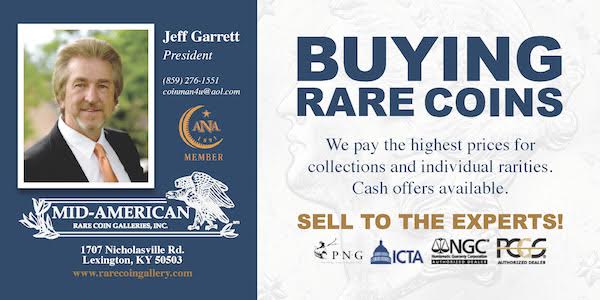
THE PAPER EMERGENCY COINS OF LEIDEN
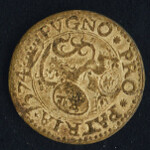

5 Stuiver or ¼ Gulden Leiden Seige Coin
drs Bouke Jan van der Veen writes:
"With interest I read the correction for the description of the Leiden siege coins of 1574.
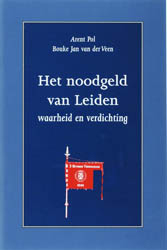 "Arent Pol and I did an overall and complete research in all the original archives from Leiden 1573-1575 to complete the story of what is called "the
first paper-money" so, it is not "paper-money"... it is coinage !! Please neglect all other "research" on this paper coins and even
the silver Leiden coins !! (Even the descriptions in the new Van der Wis/Passon catalogue Catalogus van de Nederlandse munten are far from useful i.e.
completely wrong). One of the reasons is not their mistake; our research is not widely published ... only in a book for sale after our presentation and lecture
for the 3 october commemoration 2007.
"Arent Pol and I did an overall and complete research in all the original archives from Leiden 1573-1575 to complete the story of what is called "the
first paper-money" so, it is not "paper-money"... it is coinage !! Please neglect all other "research" on this paper coins and even
the silver Leiden coins !! (Even the descriptions in the new Van der Wis/Passon catalogue Catalogus van de Nederlandse munten are far from useful i.e.
completely wrong). One of the reasons is not their mistake; our research is not widely published ... only in a book for sale after our presentation and lecture
for the 3 october commemoration 2007.
"It's also very useful to know that the original dies 1574 are kept in Leiden museum "De Lakenhal"
"Maybe it is an idea to translate the complete text of our research results in English ; then there is a complete version in English that can be used "internationally". The reasons for this project are clear ; there is too often, to many nonsense buzzing around. But where and how can we do this, do you have suggestions?"
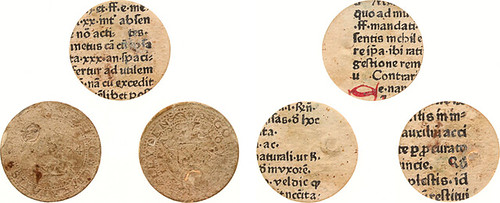
Leiden emergency money 1 gulden split apart
Perhaps our readers will have suggestions, but certainly a translation into English would be a good first step - it could then be published online or in book form. It's very interesting to learn that the coin dies still exist.
I passed this along to my friend Dr. Lawrence Korchnak who is writing a book on siege coins. -Editor
Larry Korchnak writes:
I concur with van der Veen's take on Leiden's paper coins. And, as a serious collector of siege money, I would welcome their research in English. In my effort to produce a comprehensive English language catalogue on siege coins, my research yielded a paucity of quality information regarding the Leiden issues. I will certainly purchase their book.
Below are links to our previous articles on the topic. -Editor
To read the earlier E-Sylum articles, see:
QUERY: TERM FOR PAPER PRESSED INTO COIN FORM SOUGHT
(https://www.coinbooks.org/esylum_v13n08a14.html)
THE EARLIEST PAPER MONEY ISSUED DURING A SIEGE (https://www.coinbooks.org/esylum_v13n12a16.html)
TRUTH AND FICTION OF THE 1574 LEYDEN SIEGE COINS
(https://www.coinbooks.org/esylum_v13n16a17.html)
THE EMERGENCY MONEY OF LEIDEN (https://www.coinbooks.org/v21/esylum_v21n44a12.html)
NOTES FROM E-SYLUM READERS: JULY 7, 2019
Counting the 1894-S Dimes

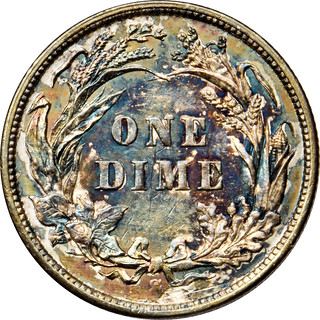
Rich Kelly writes:
Nancy and I were the first to discover the article in the October 1895 issue of the San Francisco Bulletin which explained, directly from the weigher of the SF mint, as to the reason why the 24 pieces of said issue were struck. The weigher, Frank Berdan, said that he had also purchased 2 pieces as per family tradition. And, word also came that the ex-coiner, Charles Gorham purchased two as well. What better sources could you have to explain the coin's creation? In addition, there were 3 pieces set for assay not 5. Two for special assay at the Philadelphia mint, and one for the annual assay. This left a total of 17 sent into circulation. Since 9 are known, 8 are still missing. We hope this helps to clarify the history of this coveted coin.
Rich Kelly & Nancy Oliver
Numismatic Researchers & Authors
Thanks for setting the record straight. -Editor
To read the earlier E-Sylum article, see:
STACK'S BOWERS TO SELL 1894-S DIME
(https://www.coinbooks.org/v22/esylum_v22n26a29.html)
Mystery Answer: The Sidney Daily News Building
Last week Pete Smith wrote:
I came across a photo that I found interesting because I thought it looked like the First United States Mint. I altered it slightly to remove an identifying sign. Can any E-Sylum reader identify the building and its numismatic significance?
We only had one response to this tough quiz, but it was spot-on. -Editor
Chriss Hoffman from Plano, Texas writes:
It appears to be the Amos Press building in Sidney, Ohio, home of Coin World.
Correct! The unretouched photo of the Sidney Daily New building is shown above, taken from a web page on Amos Press history. Thanks, everyone! -Editor
To read the complete article, see:
Amos Press (https://www.shelbycountyhistory.org/schs/industry/amospress.htm)
To read the earlier E-Sylum article, see:
NOTES FROM E-SYLUM READERS: JUNE 30, 2019 : Mystery Numismatic Building
(https://www.coinbooks.org/v22/esylum_v22n26a16.html)
Henning Nickel Sought for Book Photo
Winston Zack writes:
Do any E-Sylum readers, or your numismatic friends or family, own a 1953 Henning nickel counterfeit? I am finalizing my upcoming book, “Bad Metal. Copper and Nickel Circulating Contemporary Counterfeit United States Coins” and the 1953 Henning nickel is the only Henning variety in my ‘Nickel’ chapter which I have not yet located, studied, or photographically documented – although I know they exist.
If you own, or know someone who does own a 1953 Henning nickel, I would very much appreciate being contacted to arrange for a professional photograph of this piece to be included in my book. I will pay the full cost of getting the 1953 Henning nickel professionally photographed. You can contact me, Winston Zack, at winston.s.zack@gmail.com for more information.
The absolute deadline for this request of a 1953 Henning nickel photograph is July 31, 2019 in order to meet my tight publishing deadline. If a photo of a 1953 Henning nickel is provided to me after July 31, there is no promise that I will have time to include it in my project - this would be unfortunate, and I really do not want to have this variety missing from this project. However c'est la vie. Any photos of a 1953 Henning nickel published in my book will be fully cited and credited in the photo credits section at the end of the book.
As a preview of the contents of this book, the ‘Henning Nickel’ section of the ‘Nickel’ chapter promises to provide never before published information, research and analysis on Henning’s nickels, die states, and emission order which collectors will find quite valuable. In addition, it expands upon the extensive research conducted by Dwight Stuckey in his 1982 book ‘The Counterfeit 1944 Jefferson Nickel.’
The debut of this book is planned at the November 2019 Whitman Winter Baltimore Coin Expo, and an official pre-order notice will be provided in the coming weeks.
Can anyone help? This coin is an important piece of the puzzle and it would be a shame not to have a quality photo of one. Note that only the 1953 is needed. Henning used coins dated 1939, 1944, 1946, 1947, and 1953 for his obverse dies. -Editor
To read earlier E-Sylum articles, see:
HENNING COUNTERFEIT NICKELS SOUGHT IN RIVER (https://www.coinbooks.org/esylum_v18n16a19.html)
WHAT HENNING SET OUT TO COUNTERFEIT (https://www.coinbooks.org/esylum_v18n17a08.html)
CONTEMPORARY COUNTERFEIT U.S. COINS SOUGHT
(https://www.coinbooks.org/v21/esylum_v21n38a11.html)
Terracotta Franklin Plaque by Nini
Howard A. Daniel III writes:
 I received an email from the International Bank Note Society about an ad that was missing from its journal
for Dix Noonan Webb (DNW) in the United Kingdom. I looked through one of its auction catalogs; Coin, Tokens & Historical Medals on 18 & 19 September
2019, and saw a plaque for Ben Franklin which is new to me and thought it might be of interest to an Americana collector in the United States.
I received an email from the International Bank Note Society about an ad that was missing from its journal
for Dix Noonan Webb (DNW) in the United Kingdom. I looked through one of its auction catalogs; Coin, Tokens & Historical Medals on 18 & 19 September
2019, and saw a plaque for Ben Franklin which is new to me and thought it might be of interest to an Americana collector in the United States.
USA, Benjamin Franklin, 1777, a uniface terracotta plaque by J-B. Nini, b franklin americain, bust left wearing fur hat, 113mm (Greenslet GM-5; cf. Betts 548). Extremely fine, rare; holed on edge for suspension £500-£700
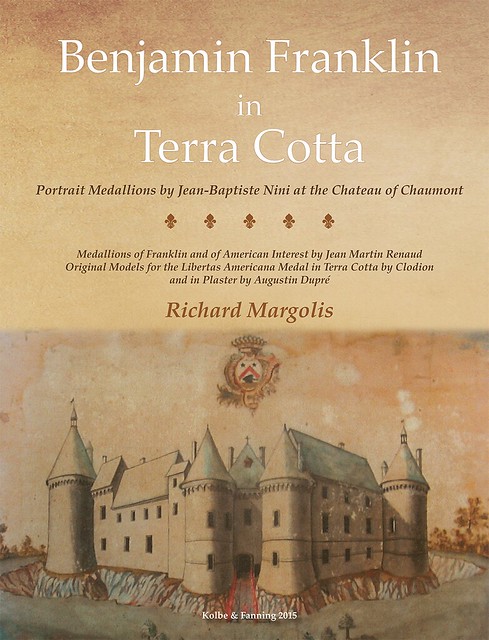 Thanks! This is an
important item, covered by the recent book by the late Richard Margolis, Benjamin Franklin in Terra Cotta, Portrait Medallions by Jean-Baptiste Nini at the
Chateau of Chaumont. . The sale is on September 18 & 19. -Editor
Thanks! This is an
important item, covered by the recent book by the late Richard Margolis, Benjamin Franklin in Terra Cotta, Portrait Medallions by Jean-Baptiste Nini at the
Chateau of Chaumont. . The sale is on September 18 & 19. -Editor
To read the complete lot description, see:
https://www.dnw.co.uk/auctions/catalogue
lot.php?auction_id=512&lot_id=63645
To read the earlier E-Sylum articles, see:
NEW BOOK: BENJAMIN FRANKLIN IN TERRA COTTA (https://www.coinbooks.org/esylum_v18n18a03.html)
BOOK REVIEW: BENJAMIN FRANKLIN IN TERRA COTTA
(https://www.coinbooks.org/esylum_v18n22a04.html)
J R Steuart Numismatic Library Information Sought
Dave Hirt writes:
Sometimes I enjoy looking through auction catalogs my library. I never know what I will come across. Recently while looking through the John Allan sale, held at Bangs, Merwin in May of 1864, a lot that caught my eye was #677: "Coins, catalogue of the Numismatic Library of an Eminent Collector", London, 1846.
I was quite surprised to see a numismatic library at such an early date, and decided to see if I could find out more about it. The lot sold to William Sumner Appleton for $2. The Appleton library was sold by Tom Elder in May of 1913, so I pulled that catalog, and found the 1846 library sale as lot 263. Although called Very rare by Elder, interest was lagging, and it only realized 25 cents.
From this point I lost track of the catalog, but to try and find out more about it, I consulted Harrington Manville's book British Numismatic Auction Catalogues (1710-1984). I knew Mr .Manville from both of us attending Frank Katen's book auctions. He was a nice gentleman, and he wrote a dedication to me on the title page of his book. Finally Manville gives a clue who the Eminent collector may be - he suggests one J R Steuart.
Since this was one of the very first numismatic libraries, I wonder if any of of our readers know anything about it.
Great question - can anyone help? -Editor
Royal Mint Coin designer Joseph Boehm
 David Pickup writes:
David Pickup writes:
The designer of the Queen Victoria jubilee head Joseph Boehm had an alleged relationship with one of the Queen’s daughters. According to a rumour he died in the daughter’s arms!
Numismatics gets especially interesting every once in a while. -Editor
To read the earlier E-Sylum article, see:
NEW BOOK: JUBILEE HEAD GOLD HALF SOVEREIGN
(https://www.coinbooks.org/v22/esylum_v22n26a08.html)
Silver Ingot Questions
Regarding Ken Conaway's new web site on silver ingots of the U.S. government, Max Hensley writes:
Thanks for including this. I own about a half dozen of these of various types and was delighted to see further information about them. Unfortunately not as much info as I'd like -- what were the shear ingots made for? Can the serial numbers be correlated with dates of issue, who were these sold to? ---but it was more than I knew!
Good questions. -Editor
To read the earlier E-Sylum article, see:
NEW WEB SITE: SILVER INGOTS OF THE U.S.
(https://www.coinbooks.org/v22/esylum_v22n26a07.html)
Adventure and Resolution Medal Exhibit
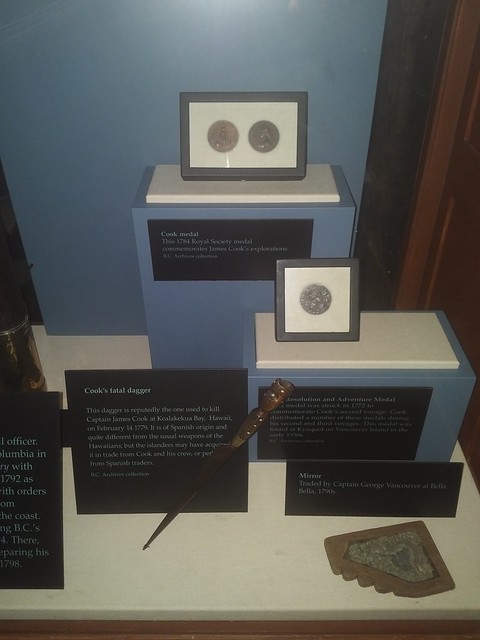 David Pickup writes:
David Pickup writes:
I was in Vancouver recently seeing my eldest daughter and went to the Museum of British Columbia. It's about $27 dollars to get in. I appreciate free museums in the UK! The museum had an Adventure and Resolution medallion presumably given by Capt Cook. It was so badly lit you could not see it. There was a picture of some tokens but that was it.
Thanks. Looks like a nice exhibit otherwise. -Editor

ARTICLE HIGHLIGHTS JAMES BAILEY'S COIN FINDS
Readers may recall Jim Bailey, the metal-detecting historian from Rhode Island who reached out to us in 2016 while writing an article for The Colonial Newsletter about specimens of Arabian silver coins found by detectorists at Colonial Period sites in New England. An article this week in the Providence Journal profiles Jim, his finds, and his research. Here's an excerpt, but be sure to see the complete article online. -Editor
 The first documented arrival of a ship bringing enslaved
people direct from Africa to Newport, in 1696, was not a scheme by a Rhode Islander seeking his fortune in the slave trade. It was a scheme by a pirate who
already had a fortune — an emperor’s fortune — that he needed to hide in plain sight while crossing the Atlantic.
The first documented arrival of a ship bringing enslaved
people direct from Africa to Newport, in 1696, was not a scheme by a Rhode Islander seeking his fortune in the slave trade. It was a scheme by a pirate who
already had a fortune — an emperor’s fortune — that he needed to hide in plain sight while crossing the Atlantic.
An amateur historian from Warwick, James Bailey, 52, arrived at this conclusion by way of historical research and his metal detector, which helped him find Colonial buckles, pewter spoons, a 1-pound cannonball and one slim coin, about the size of a dime. It’s a dime on which a part of accepted Rhode Island history turns.
The coin, he said, is proof that the ship carrying abducted Africans to be sold in Newport was not only a Rhode Island first, but also the getaway plan for a spectacular Red Sea pirate heist.
The unusual coin is inscribed in Arabic. It lay in a Middletown field for three centuries, passed over by livestock, plows, storms and seasons at what is now Sweet Berry Farm, a pick-your-own-fruit destination with specialty foods, a gift shop and dining areas indoors and out.
 The coin, dug up by Bailey in 2014, became the first dot
in a line that led to the arrival in late May 1696 of a slave ship direct from Africa, and before that to the ransacking by pirates of the flagship of the
Mughal emperor Aurangzeb, ruler of the entire Indian subcontinent. The attack jeopardized Britain’s trade relationship with India, and Rhode Island officials
were suspected of hiding pirates, which they were. British trade authorities discussed revoking the colony’s charter.
The coin, dug up by Bailey in 2014, became the first dot
in a line that led to the arrival in late May 1696 of a slave ship direct from Africa, and before that to the ransacking by pirates of the flagship of the
Mughal emperor Aurangzeb, ruler of the entire Indian subcontinent. The attack jeopardized Britain’s trade relationship with India, and Rhode Island officials
were suspected of hiding pirates, which they were. British trade authorities discussed revoking the colony’s charter.
The dots also connect to a mutiny in Spain, an entire ship and crew abandoned at sea, the deliberate sinking of the pirate ship that had plundered Aurangzeb’s flagship, and the escape of the most wanted man on Earth, who disguised himself, his ship and his crew as slavers. The guise got Henry Every from an island east of Madagascar, around the Cape of Good Hope in Africa, across the Atlantic, into the Bahamas, where he changed ships, and on to Newport without being captured.
Having carried off the plunder from one of the most successful, although brutal, pirate attacks in history, Every disappeared after he reached Ireland. Some say he lived out his life in luxury. Others say he was cheated and died penniless. The fates of at least five pirates, however, are known. They were hanged. Many others disappeared into Colonial landscapes, unloading their telltale coins, sometimes swapping them for land or asking silversmiths and artisans to transform them into statements of wealth.
Some of the small coins, however, entered circulation. In recent years, 12 silver coins like the one found in Middletown have turned up in Rhode Island, Massachusetts and Connecticut. Hobbyists with metal detectors found most of them, but Connecticut’s state archaeologist, Brian Jones, reported that one turned up in a dig last August at the Lt. John Hollister archaeological site, in Glastonbury. As Jones wrote in the September 2018 Newsletter of the Archaeological Society of Connecticut: “Many of these pirates used Newport, Rhode Island as a safe haven, and the coins were eagerly picked up by colonists for whom currency was in very short supply.”
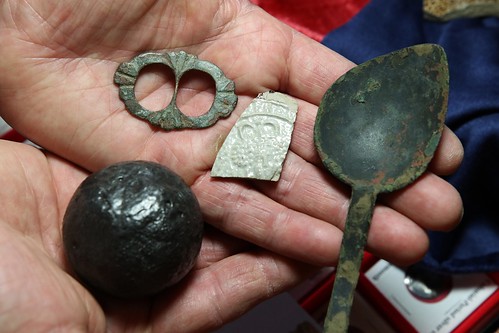 Bailey works in security at the Rhode Island Department of Corrections, occasionally bringing his metal
detector to scan the prison yard for weapons.
Bailey works in security at the Rhode Island Department of Corrections, occasionally bringing his metal
detector to scan the prison yard for weapons.
His hobby is hunting for artifacts. He studies early maps to find promising sites. In 2004, he saw on a map from the late 1700s where a house once stood in Middletown. He asked the Sweet Berry Farm owners, Jan and Michelle Eckhart, for permission to hunt there with his detector. They granted it.
“He’s an amateur, but he’s really professional, if you ask me,” said Jan Eckhart, stopping by two tables where Bailey had spread out maps, photos and portable display cases to talk about his findings.

Bailey keeps his best coins in a safe deposit box. They include the comassee, an Oak Tree shilling and an Oak Tree two pence, both issued by the Massachusetts Bay Colony, as well as a Spanish half real (a crude silver coin worth about 6.25 cents), issued in 1727. He found all four on the farm.
He also brought his article, published in August 2017 by The Colonial Newsletter, a numismatics research journal, about tracing the comassee, the oldest Arabic coin found in North America, and discovering that it linked the slave ship with pirates.
“This story could never have been told 30 years ago,” Bailey said, referring to the rise of the internet and advances in metal detectors.
Bailey, who confines himself to primary source documents, painstakingly studied vital records, letters, court testimony and other digitized materials.


LEFT: George Washington inaugural button
RIGHT: Oak Tree shilling
To read the complete article, see:
Pirate tale unearthed by amateur historian
from Warwick (https://www.providencejournal.com/news/20190705/pirate-tale-unearthed-by-amateur-historian-from-warwick)
Jim Bailey adds:
• Four coins have been added to the initial population of nine coins detailed in the study for a total of 13 recovered coins. One coin was discovered in 2017, and the other three were found in the second half of 2018. The coins were recovered in Massachusetts, Connecticut, and Rhode Island. All coins are typical of those noted in the 2017 study: the coins circulated in the Red Sea region; the majority came from Yemen where the Gunsway took aboard its immense cargo of gold and silver later captured by Henry Every (one coin was minted in Cairo, Egypt); and all the coins date through the 17th century but not later than 1695, i.e., the year the Gunsway was captured. Most of the coins were recovered by metal detecting hobbyists, but one of the specimens found last summer in 2018 was recovered in an archaeological excavation in Glastonbury, CT.
• Further research of primary source documents continues to offer evidence of pirates settling with their loot in New England after voyaging with Henry Every aboard the Fancy. Richard Smithsend was one such pirate. He came ashore in Connecticut after the Fancy’s company broke up in the Bahamas and went their separate ways. Amazingly, he eventually ended up living the rest of his life in Glastonbury, CT, where one coin, a 1692 silver comassee from Yemen, was recovered last year.
Further coin recoveries are likely as this story becomes better known.
Many thanks to Jim for bringing this story to light and sharing his research with us. It's a fascinating chapter in American history. -Editor
To read the earlier E-Sylum article, see:
QUERY: YEMENI COINS IN COLONIAL AMERICA (http://www.coinbooks.org/esylum_v19n33a15.html)
COLONIAL NEWSLETTER AUGUST 2017 ISSUE PUBLISHED
(http://www.coinbooks.org/v20/esylum_v20n44a03.html)
ARABIC COINS IN MEDFORD MASSACHUSETTS 1787
(https://www.coinbooks.org/v20/esylum_v20n45a29.html)
NEW BANK OF ENGLAND MUSEUM EXHIBIT
The Bank of England Museum is one of my favorite numismatic museums. A new exhibit displays selected artifacts from their collection. Here are a few from an article in Londonist. -Editor
The Bank of England is 325 years old. To mark the milestone, a new exhibition pulls together 325 fascinating objects from the financial institution's past. Bank of England Museum curator, Jenni Adam, singles out a handful of these objects for Londonist.
Proof for Jacobite banknotes (1745)
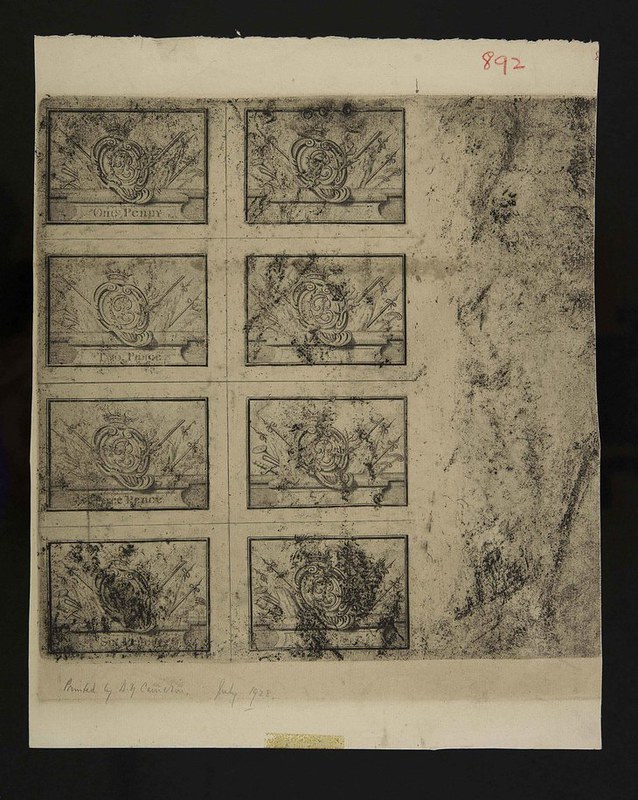
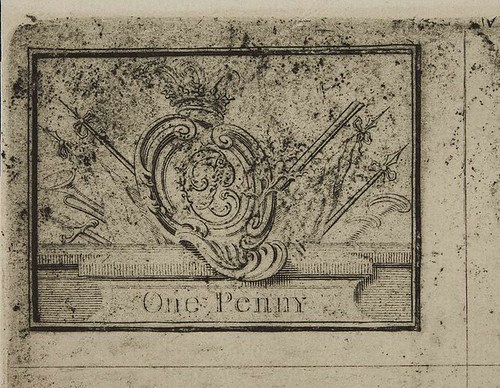 This is a design for Jacobite banknotes, made in 1745 by engraver Robert Strange. He was commissioned by Charles
Edward Stuart (Bonnie Prince Charlie) to produce printing plates for banknotes that would be used to pay Jacobite expenses during the rebellion. But the
printing plate — and banknotes — were never used. It was abandoned after the Battle of Culloden, and only rediscovered in the 1920s.
This is a design for Jacobite banknotes, made in 1745 by engraver Robert Strange. He was commissioned by Charles
Edward Stuart (Bonnie Prince Charlie) to produce printing plates for banknotes that would be used to pay Jacobite expenses during the rebellion. But the
printing plate — and banknotes — were never used. It was abandoned after the Battle of Culloden, and only rediscovered in the 1920s.
Hand scales for weighing and testing coins (1749)

This is a set of hand scales for weighing gold and silver coins from other countries, which could be accepted because of their value as bullion. The weights are labelled with the name of the coins they represent, which helps a user make sure an unfamiliar coin is genuine (forgeries would usually be lightweight, because they wouldn’t contain as much gold as a genuine coin).
£40 banknote in the name of Elizabeth Head (1702)

This is one of the oldest banknotes we have in the collections, from 1702. At this point the notes were only part-printed and most of the important details (value, date, number etc) were written in by hand. We picked this one because it’s the earliest note that names a woman as a payee, Elizabeth Head. It’s for £40 which in 1702 was a huge amount of money, around £9,200 — this certainly wasn’t an everyday method of payment for most people.
To read the complete article, see:
Eye Up A One Hundred Million Pound Banknote At This Museum
(https://londonist.com/london/museums-and-galleries/bank-of-england-objects-325-years)
VOCABULARY TERMS: CLAD, CLADDING
Dick Johnson submitted this entry from his Encyclopedia of Coin and Medal Terminology. Thanks. -Editor
Clad, Cladding. Bonding together thin layers of metal of differing alloys to form a sandwich construction. Technically the outer or exposed layers are termed the clad layer, or lamina, the internal layer is the core. This is done in every instance for the physical characteristics of the outer or clad composition, as for the color, hardness, appearance, and electric sensitivity of this surface. The use of the core is generally one of lower cost than the clad metal. The line separating the core from the clad metal, called the boundry, it can be observed on the edge of U.S. coins minted after 1965 (but not those of some European coins, as Sweden, where upsetting is designed to cover the core on the edge).
Medals were first clad as early as 1789. In that year Barton's metal was used for the George III Recovery Medal by J.P. Droz (Brown 311) struck at Matthew Boulton's factory. Barton's metal was formed by rolling strips of silver (or gold) on a copper core with adhesion by fusion.
In 1964 the United States enacted a coinage law that required U.S. coins to be made of clad metal. Faced with a drastic coin shortage, a world-wide silver shortage and rising metal prices, the Treasury Department chose to turn to a copper nickel clad metal over a copper core for all former silver coins, dimes, quarters and half dollars.
This was a brilliant solution. Not only did it meet all the criteria of a circulating coin composition (including the demanding needs of the vending machine industry) but also considered the metal salvage of this composition. Skeleton scrap of this clad composition could be melted and easily reformulated back into a copper nickel formulation.
How clad strip is made. Ingots of the correct composition are rolled repeatedly to a thickness several times the thickness of the intended coin. They are metal cleaned by pickling. The layers are then placed in a rolling mill in proper sequence, the core between the two outer layers. They can be roll bonded if the metal strips are heated, then rolling is done under heat and pressure. If they are cold rolled they can be bonded by explosion bonding. The strips are then successively rolled until the required thickness is obtained.
Since January 1994 clad strips of copper nickel lamina on copper core are supplied to the United States Mints (Philadelphia and Denver) by PMX Industries, Cedar Rapids, Iowa, which uses the roll bonded method. Each strip weights between 3,000 and 7,000 pounds and are approximately 1,000 feet long. The strips have the following dimensions:
Strip Width
Thickness
50 Cent . . 12 9/16-inch (319.08mm) .0685-inch (1.740mm)
25 Cent . . 12 13/16-inch (325.43mm) .0545-inch (1.384mm)
10 Cent . . 12 11/16-inch (322.26mm) .041 -inch (1.041mm)
The strip must be manufactured within a permitted tolerance of .0015-inch (.038mm) thickness for clad strip of any denomination.
The mints blank the strips and return the skeleton scrap strips to the supplier. The supplier repossesses the scrap by adding fresh nickel to the formulation to the correct formula (75% copper 25% nickel) for new copper nickel clad layers.
The mints blank about 75% of the strip (73% at Philadelphia Mint) and return the balance. The blanks are upset by upsetting machines then struck in coining presses within the mint.
More recently, the U.S. Mint has been contracting the blanking to private industry as well as the formulation and rolling. Thus economies are achieved by not having to ship the skeleton scrap for reprocessing. The mint receives blanks for upsetting and striking within the mint.
Clad coinage characteristics. When clad blanks are struck, particularly during coining, the surface displacement comes only from the outer lamina on each side. The inner core is unaffected. On solid blanks metal is drawn from deep within the blank in addition to surface movement into the die cavities. The boundary on clad blanks literally acts as an edge beyond which no metal flow occurs in the core. This is quite evident when the lamina becomes separated from the core. To a degree, clad compositions effectively eliminate suction or ghosting in struck pieces.
Clad anomalies. Potential for a new group of errors occurred once a clad composition was chosen for national coinage. The debonding of the clad lamina layer, created a new class of lamination errors. One anomaly can occur before the coin is struck – causing a lightweight blank and very poor detail – or another after the coin is struck, with clad metal sometimes still in place, more often separated. The separating of the clad layer is called peeling.
Should the separated lamina flake off and fall onto another blank while in the coining press it could be impressed into another coin; often this is a letter (from the high stress area of the legend) and is called a dropped letter. If the flake is still attached to the coin it is called a clamshell by collectors, the point where it is still attached is called the hinge.
Reference:
B12 {1969} Young.
CH82 {1998} Doty, p 36 (Barton's metal).
Looking for the meaning of a numismatic word, or the description of a term? Try the Newman Numismatic Portal's Numismatic Dictionary at: https://nnp.wustl.edu/library/dictionary
Or if you would like a printed copy of the complete Encyclopedia, it is available. There are 1,854 terms, on 678 pages, in The Encyclopedia of Coin and Medal Technology. Even running two a week would require more than 19 years to publish them all. If you would like an advance draft of this vital reference work it may be obtained from the author for your check of $50 sent postpaid. Dick Johnson, 139 Thompson Drive, Torrington, CT 06790.

THEODORE JOSEPH VENN (1860-1936)
 Theodore Joseph Venn
(1860-1936), was born on October 1, 1860, in Pittsburgh, Pennsylvania, the third of six children, son of German immigrants : Dr. Ferdinand J. Venn (1824-1896)
of Prussia, and Margaretha "Maggie" Oerke (1835-), of Baden.
Theodore Joseph Venn
(1860-1936), was born on October 1, 1860, in Pittsburgh, Pennsylvania, the third of six children, son of German immigrants : Dr. Ferdinand J. Venn (1824-1896)
of Prussia, and Margaretha "Maggie" Oerke (1835-), of Baden.
Chicago printer, proofreader, and numismatic author, Theodore J. Venn was a prolific writer on American numismatic subjects publishing dozens of books, pamphlets, and articles on large and half cents, $3 gold pieces, Two Cent pieces, and Liberty Nickels, and many more. Only a small list is found here.
In 1870, he lived with his family in Kilbuck, Allegheny County, Pennsylvania. The 1870 U. S. Census reports him born in Germany.
 In 1880, he worked in
Pittsburgh, Pennsylvania, as a printer.
In 1880, he worked in
Pittsburgh, Pennsylvania, as a printer.
In 1885, he began assembling a complete set of U. S. Large Cents which, he published in 1915.
In 1889, the Chicago City Directory lists him living at 172 North Clark Street, Chicago.
In 1900, he lived with his brother Clement and his family at 423 Center Street, Chicago, Illinois, where he worked as a proofreader in charge at Inter-Ocean, an old Chicago newspaper.
On December 14, 1904, he married Anna Weirich (1868-1934), a native of Wisconsin also born of German immigrant parents, at Milwaukee. They had a daughter Theodora Ferdinanda Venn (1906-).

In December 1911, he was elected a member of the Chicago Numismatic Society.
In 1913, he lived at 2034 Lane Court, Chicago.
In August 1913, Ben Green assisted him in applying for membership in the ANA.
In September 1913, he became ANA Member No. 1718.
In December 1920, he read a paper titled : "On Creating a Permanent Interest in Numismatics." before the Chicago Numismatic Society at their meeting.
Venn published his article, "Coinage and Survivorship," The Numismatist, July (1921) : 290, which points out that gold coins, for example, may be much scarcer than the U. S. Mint records show due to melt downs when the market value of gold excels that of face value.
Venn published his article, "What Are Most of the New Coin Collectors Collecting," The Numismatist, August (1921) : 334-335, perhaps the earliest demographic study on coin collecting,
Venn published his article, "Are the "Daddy Dollars" Again Coming Into Their Own," The Numismatist, November (1921) : 516-517, on collecting old U. S. silver dollars.
In the November 1923 issue of The Numismatist, on page 546, it was reported that Venn published an article, "Great Rarities Among American Coins," The Bulletin (a Bankers periodical).


In the November issue of the Banker's Equipment-Service Bulletin, Venn published two articles, "Interesting Old Coins Bring Good Prices," about numismatic auction market prices; and "Coppers Worth Their Weight in Gold". In the January 1924 issue he published "Tracing the History of the U. S. Mint Over 130 Years."
In July 1924, he published in Banker's Equipment-Service Bulletin, "Old U. S. Gold Coins Bring More Than Face Value."
In August 1925, he published in The Numismatist, on page 413 "Coins of Our Youth".
In August 1925, he published in Banker's Equipment-Service Bulletin, "If a Customer Should Hand You a Beaver Coin." He describes these gold issues and those of Clark, Gruber & Co.
In 1930, he worked as a proofreader for the Chicago Tribune and lived at 38 North Lincoln Street, Chicago, Illinois.
He read a paper,"A Few Hints On Coin Collecting," at the ANA Convention at Pittsburgh, his native city. The article was published in The Numismatist, February 1936.
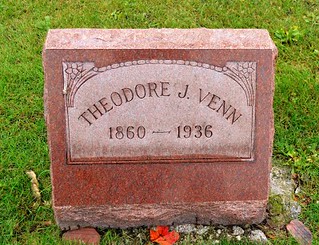 He died of apoplexy on
February 4, 1936, at Grant Hospital. He had lived at 4647 North Lincoln Street, Chicago.
He died of apoplexy on
February 4, 1936, at Grant Hospital. He had lived at 4647 North Lincoln Street, Chicago.
To read the complete article, see:
VENN, THEODORE JOSEPH (https://sites.google.com/a/
numismaticmall.com/
www/numismaticmall-com/
venn-theodore-joseph)
The entire inventory of the Lupia Numismatic Library is for sale. Individual items will be available before the remaining archives are broken up into parcels sold at philatelic auctions in the U. S. and Hong Kong. Check NumismaticMall.com frequently as dozens of new items with estimates will be posted daily until everything is sold.
All inquiries will be given prompt and courteous attention. Write to: john@numismaticmall.com .
BENEFITS OF THE 2019-W QUARTERS PROGRAM
Vic Mason of Mamaroneck, NY submitted these thoughts on the benefits to numismatics of the new 2019-W quarters. Thanks! -Editor
 I just sent a letter to Bill Gibbs at Coin World providing interesting numbers for the estimated
distribution of the “W” quarters of the United States Mint’s circulating rarities program. I could do that only thanks to the heightened vigilance of the staff
at my local branch bank of JP Morgan Chase. They saved some of the new Guam “W” quarters for me, in gratitude. I think I’ve turned them into dedicated coin
collectors!
I just sent a letter to Bill Gibbs at Coin World providing interesting numbers for the estimated
distribution of the “W” quarters of the United States Mint’s circulating rarities program. I could do that only thanks to the heightened vigilance of the staff
at my local branch bank of JP Morgan Chase. They saved some of the new Guam “W” quarters for me, in gratitude. I think I’ve turned them into dedicated coin
collectors!
The ideas I would like to share with E-Sylum readers about this experience are several. First, since early April, when the Mint surprised us by announcing this new program of circulating rarities, I have alerted numerous friends, relatives, neighbors, commercial acquaintances, and others to the Mint’s “W” quarters program, to boost interest in coin collecting. One immediate effect has been that a great many “generalist” members of the public, friends and their friends, have come to me with stories about their collections of coins, especially those inherited from relatives. They ask me to look them over, to see whether they have anything of value. I always tell them, before seeing their coins, that numismatic ethics requires me to say I am not buying anything from them, only informing them of what they have. They appreciate that. I add that if they do have anything significant, I will direct them (or accompany them) to the famous Stack’s-Bowers coin shop on West 57th Street, near Carnegie Hall, in Manhattan, a store few have ever heard of.
One lady had a beautiful Mint State “golden” 2000-P Maryland State quarter which at first got me very excited, because I didn’t know what I was looking at. But when I emailed Andrew Bowers at Stack’s-Bowers about this find, he said it had probably been plated to fool a buyer. “We see those plated coins now and then,” he told me. I then told the lady about the most famous case of such trickery in American coinage in 1883, when new nickels were plated in gold to be passed off as $5 gold coins, until the design was changed later that year to add the word “CENTS” at the bottom of the reverse. So the experience turns into a numismatic history lesson as well!
Second, it has been enjoyable finding a couple of three-figure coins in those hunts, both silver dollars. One was an 1892-S Morgan dollar which a friend’s mother had had in a simple silver necklace holder for decades. When my friend and I went to Stack’s-Bowers a few years ago, Andrew Bowers declared the coin genuine and said it was in extremely fine condition. When I sent it to Professional Coin Grading Service (PCGS) for grading and encapsulation, it came back XF 40. Andrew had explained to my friend what his store’s pricing policy was on buying and selling coins. Since my friend needed the money, she was then grateful when I paid her well over the wholesale price that a dealer would give her.
Third, virtually every ordinary collection of coins I’ve seen – most of them just bagged or boxed loosely in a jumble – has had a lot of old common silver dimes, quarters, halves and dollars. Most of the owners I speak with have little or no awareness of the difference between face values stamped on the old silver coins (all pre-1965 silver coins and the pre-1971 silver-clad halves) and the current spot-market value of silver bullion. So they are pleased to learn that they often have hundreds of dollars worth of silver they were unaware of – coins they can quickly turn into cash, if they choose. Fourth, I am always on the alert for rare varieties highlighted in the Cherrypickers’ Guide by Bill Fivas and J.T. Stanton.
Fifth, I have lately been urging owners of the common pre-1965 coins not to turn them in as bullion but rather to keep them and to put them in books for collections of uncertified coins. For example, one neighbor recently showed me his father’s collection mostly of common-date and well-worn Indian head cents, Lincoln wheat cents, old Canadian large and small cents, old Buffalo and Jefferson nickels, Barber and Mercury dimes, Franklin and Kennedy halves, Morgan dollars, and Peace dollars. I told him (and his mother) that they had several hundred dollars worth of silver. But in memory of his father, I suggested he get the “blue books” (or whatever is sold these days) for uncertified coins “and enjoy the collection,” in his dad’s memory. That is what he and his mother did.
The biggest excitement we got from going through that collection was to find the No. 1 key date of the Peace dollars series (aside from the uncollectible 1922 High Relief dollar): the 1928 coin minted in Philadelphia, with a population of only 360,649. His coin was in extremely fine condition, and I showed them that in XF 40 it was listed at $320 in the 2020 edition of The Red Book. I advised him that since current PCGS CoinFacts tables of recent auction results indicate he was unlikely to get the sums suggested by current pricing tables, he just keep that and all the other Peace dollars he has in a book for uncertified coins. He agreed and went out to buy the books to hold all the coins in a more organized fashion – and to enjoy the collection for the first time.
Great stories! Thanks for sharing. We all have opportunities to reach out to the non-collecting public in various venues, but as Vic noted, programs like the 2019-W quarter provide new openings for discussion. -Editor
To read the earlier E-Sylum articles, see:
ON THE MINT'S MANUFACTURED RARITIES (https://www.coinbooks.org/v21/esylum_v21n44a21.html)
MORE ON THE MINT'S MANUFACTURED RARITIES
(https://www.coinbooks.org/v22/esylum_v22n16a14.html)
ACTOR PYFROM FINDS VALUABLE 2019-W QUARTER
(https://www.coinbooks.org/v22/esylum_v22n16a15.html)
LOOSE CHANGE: APRIL 28, 2019 : Golino on the 2019-W Quarters
(https://www.coinbooks.org/v22/esylum_v22n17a28.html)
2019 WEST POINT QUARTERS COMING TO THE RED BOOK
(https://www.coinbooks.org/v22/esylum_v22n23a04.html)

AUDIO: MATT ROTHERT SR.
On July 2, 2019 the Encyclopedia Of Arkansas Minute public radio program discussed numismatist Matt Rothert. -Editor
A Camden furniture merchant was responsible for a phrase we see every time we open our wallets. Matt Rothert, Sr., was born in Indiana in 1904 and moved to Camden twenty years later. He founded the Camden Furniture Company, serving as its president until he retired in 1975. But his true love was coin collecting, a passion he developed when he found his father’s old coins.
Rothert was active in the American Numismatic Association, serving as its president from 1965 to 1967. He wrote three books, including the award-winning Arkansas Obsolete Notes and Scrip. But it was at church one day in 1953 that he first noted that only coins were marked with “In God We Trust,” leading him on a personal crusade to see the phrase added to paper currency. Rothert gave speeches and wrote letters in support of his plan, leading Congress to pass legislation that President Dwight Eisenhower signed into law on July 11, 1955.
 In addition to his Arkansas book and work to promote the "In God We
Trust" slogan, in 1963 Rothert published a Whitman "Black Book" titled A Guide Book of United States Fractional Currency: An Illustrated
History and Catalog Listing with Valuations for all Issues of Postage and Fractional Currency of the United States, 1862-1876. I came across this booklet
early in my numismatic career, and I've been grateful ever since.
In addition to his Arkansas book and work to promote the "In God We
Trust" slogan, in 1963 Rothert published a Whitman "Black Book" titled A Guide Book of United States Fractional Currency: An Illustrated
History and Catalog Listing with Valuations for all Issues of Postage and Fractional Currency of the United States, 1862-1876. I came across this booklet
early in my numismatic career, and I've been grateful ever since.
If memory serves I found the diminutive booklet at a local library while seeking information about an odd piece of paper money I acquired after my grandfather passed away. I learned from the book that it was a 25 cent Fifth Issue Fractional Currency note from 1874 depicting Secretary of the Treasury Robert Walker. I had no idea that the U.S. had printed money worth less than a dollar, and I was even more fascinated to learn from the short introduction about the Civil War specie panic and the myriad money substitutes that came into use. I didn't know it yet, but I was hooked and became a collector of U.S Civil War money that day, eventually specializing in U.S. Encased Postage stamps. Thanks, Mr. Rothert! -Editor

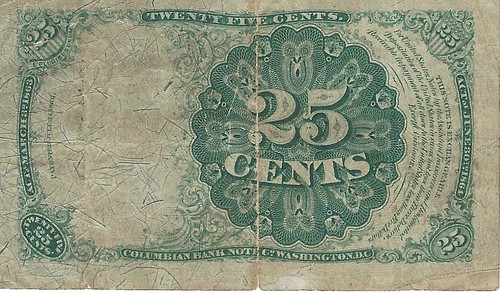
My first Fractional Currency note
To read the complete article, see:
Encyclopedia Of Arkansas Minute: Matt Rothert Sr.
(https://www.ualrpublicradio.org/post/encyclopedia-arkansas-minute-matt-rothert-sr)
SUNDMAN LECTURES AT THE AUGUST 2019 ANA
I won't arrive early enough at this year's American Numismatic Association World's Fair of Money to enjoy the annual Sundman Lectures, but anyone attending on Wednesday August 14th should consider registering. Numismatic fellowship at the luncheon is enjoyable, and the lectures are top-notch. -Editor
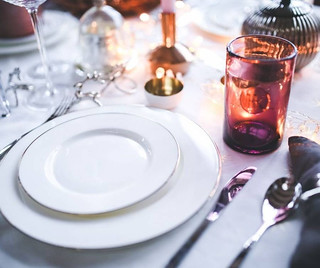 During this year's
Sundman Lecture Series, Aug. 14, the future of the hobby and what it means for collectors will be discussed, focusing on the theme "The Future of Money
& Collecting."
During this year's
Sundman Lecture Series, Aug. 14, the future of the hobby and what it means for collectors will be discussed, focusing on the theme "The Future of Money
& Collecting."
Enjoy a catered lunch between lectures from 12:15 to 1:45 p.m. Attendees may choose from rosemary and garlic grilled chicken, roasted vegetable lasagna or hangar steak.
The luncheon is $20 per person and is underwritten by Maynard Sundman/Littleton Coin Co. Lecture Series Endowment and David Sundman. Registration is required by July 22.
Sundman Lecture Presenters
10:00 a.m. — Gary Adkins: "Education's Role in the Future of Money"
11:15 a.m. — Michael Marotta: "What Does the Future of Money Look Like"
2:00 p.m. — Mark Benvenuto: "Local Currencies in the Day of Global and Electric Money"
3:15 p.m. — Ron Guth: "Back to the Future of Money"
The lectures are free and open to the public but reservations are required.
To make a reservation, see:
https://www.money.org/worldsfairofmoney#register
MONEY TALKS AT THE AUGUST 2019 ANA
The Money Talks at this year's American Numismatic Association World's Fair of Money begin on Thursday, August 15, 2019. It's a great lineup of speakers. -Editor
Money Talks provide members a forum in which to share their views and research with fellow hobbyists. The numismatic lectures are presented each year at ANA conventions and are free to attend. Presentations are 30 to 45-minute programs, including questions from the audience.
9 a.m. — Franklin L. Noel
"A New Constellation: Nova Constellatio Coppers & the Birth of the Republic"
10 a.m. — Michael Shutterly
"Golden Portraits of Byzantium: Every Picture Tells a Story"
11 a.m. — Dr. Peter Huntoon
"Nuclear Silver: When Treasury Collided with Physics"
Noon — Gary Hermann
"The Coins & Medals of Laura Gardin Fraser: A Lifetime of Numismatic Artistry & Excellence, 1912-1968"
1 p.m. — Robert Bair
"Louis G. Kaufman, His Fabulous Coin Collection, and RARCOA's Numismatic Find of the Century"
2 p.m.
Q. David Bowers, Steve Hayden, Fred Holabird, Bill Hyder, Neil Musante & David Schenkman, with Susan Trask (Moderator) "Meet the Experts: A Symposium
on the Why, What & How to Collect Tokens and Medals"
3 p.m.
Q. David Bowers, Steve Hayden, Fred Holabird, Bill Hyder, Neil Musante & David Schenkman, with Susan Trask (Moderator) "Meet the Experts: A Symposium
on the Why, What & How to Collect Tokens and Medals"
4 p.m. — John Baumgart
"Gaining Insight Through Studying Die Varieties"
Friday, August 16
9 a.m. - Jamie Franki
"Mister Lincoln Rose"
10 a.m. — Tom Babinszki
"The Challenge of Making Currency Accessible to the Visually Impaired"
11 a.m. — David Finkelstein
"Historical Documents Provide Insight About 1794 U.S. Silver Coin Production"
Noon — Douglas Mudd
"Midieval European Coinage Part I, AD 476 to AD 800"
1 p.m. — Dr. Michael Fuljenz
"Fake(s) News: The Proliferation of Counterfeits & How to Avoid Becoming a Victim"
2 p.m. — Greg Allen & Jeff Garrett
"What's Goin On At the Coin Show"
3 p.m. — Rod Gillis
"Strategies to Dispose of Your Collection"
4 p.m. — Harvey Richer
"The Gold Coins of Newfoundland"
For additional information contact Sam Gelberd at sgelberd@money.org.
To read the complete article, see:
https://www.money.org/worldsfairofmoney/moneytalks
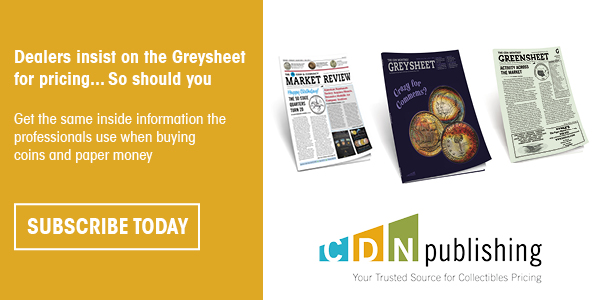
THE RICHMOND COLLECTION SALE
Numismatic libraries are incomplete without copies of the David Lawrence Rare Coins sale catalogs of The Richmond Collection. John Feigenbaum was running the coin firm created by his father David Lawrence Feigenbaum when he decided to try expanding into the auction business. In an article published this week on the site of John's CDN Publishing business (the Coin Dealer Newsletter pricing guides), John discusses the monumental effort it took to hold that classic sale. -Editor
 Years ago
(circa 2003) as the owner of David Lawrence Rare Coins, I had the idea of expanding our business from direct sale-only to live auction. I had the perfect entry
point as I was offered a slot to hold the auction in conjunction with the New York Invitational coin show in downtown Manhattan. “No problem” I said. “I’ll
take the slot and just solicit auction lots from my huge list of existing clients.” Boy, was I naive. I sent out the email to customers and all I heard was
crickets. The other auction companies were not happy (understatement) to hear me tread on their turf and we didn’t have the software to provide even basic
auction services like online bidding, etc. In 2003 there were very few third-parties offering such things either.
Years ago
(circa 2003) as the owner of David Lawrence Rare Coins, I had the idea of expanding our business from direct sale-only to live auction. I had the perfect entry
point as I was offered a slot to hold the auction in conjunction with the New York Invitational coin show in downtown Manhattan. “No problem” I said. “I’ll
take the slot and just solicit auction lots from my huge list of existing clients.” Boy, was I naive. I sent out the email to customers and all I heard was
crickets. The other auction companies were not happy (understatement) to hear me tread on their turf and we didn’t have the software to provide even basic
auction services like online bidding, etc. In 2003 there were very few third-parties offering such things either.
But then the phone rang… our biggest client ever called. He’d seen a tiny mention in a Coin World press release and asked me, “John, do you think my coins would do ok at auction?” I almost fell out of my chair, but quickly recovered and told him I’d be down in Naples (FL) the next day to visit him personally and discuss the matter. To make a long story short, the following July we sold the Richmond Collection, Part I for approx $13 million. The 3 parts would eventually total around $24 million — at the time one of the highest dollar amounts ever realized for a single collection. (The collection featured major rarities including 1880 Coiled Hair Stella, 1885 Trade dollar, 1894-S dime and almost everything else in the Red Book.)
It was a thrilling time. But EXHAUSTING. For 2 years, I barely slept and my tiny company was overwhelmed by the herculean task of maintaining the regular business while dealing with these 3 auctions. The sales were a HUGE success and we built incredible software along the way that paved the future of DLRC via weekly internet sales.
We went from a sleepy little enterprise of 7-8 employees to a peak of 25 by 2007, and I’m not sure I was ever the same after. Over a decade later in 2019 I easily recall the stress of those days, wearing every hat in the office, often waking in the middle of the night recalling a phone call I forgot to return, a picture that needed touching up.
I have no regrets about this time. It was everything I wanted to achieve in my career and for my company. However, I get nervous feeling just recalling the stress that accompanied those sale events.
Indeed. It's a big undertaking, even without the need to set up new technology. But that's how progress is made - try something new and work it through. For another account of setting up an auction business, see the next article in this issue. -Editor
To read the complete article, see:
The live auction business is exhausting….but don’t
take my word for it. (http://blog.greysheet.com/the-live-auction-business-is-exhausting-but-dont-take-my-word-for-it/)
THE LEGEND NUMISMATIC AUCTION BUSINESS
In the previous article in this issue John Feigenbaum recalled his difficult experiences in setting up a live coin auction business for David Lawrence Rare Coins. He was reminded of his Richmond Sale experience by an article published by Legend Numismatics owner Laura Sperber about her similar difficult experiences in setting up her auction business. Here's an excerpt - see the complete article online. -Editor
 When the original
Superior was for sale, I badly wanted to buy it. It had a great manager (the late Steve Deeds) and had been around a long time. I just knew way back when (20+
years ago, that auctions were the future in selling coins). My partner Bruce put his foot down and said no. So no it was.
When the original
Superior was for sale, I badly wanted to buy it. It had a great manager (the late Steve Deeds) and had been around a long time. I just knew way back when (20+
years ago, that auctions were the future in selling coins). My partner Bruce put his foot down and said no. So no it was.
Then I got the itch really bad a few years later. I figured to try a different route. I knew Dan Morphy from my friend John Snyder and his boss at Diamond comics, Steve Geppi. So I figured why not partner, he is outside of coins and has a huge customer base. Sadly Dan, did not understand coins at all and he clashed with my style. That association was brief.
A couple of years later, I contacted him again and tried for a second time. We had small success until a very flawed computer program he offered us failed. We turned to an outside source and ended up losing $600,000.00.
Even a small start up required a ton of money, even more work, and a lot of great people. After losing $600,000.00 money was tight. At that point I was fighting up hill with Bruce who did not want me to do it. My vision was undeterred.
I started reaching out to all of my best customers. Surprise! They all gave me some pretty cool stuff that was duplicates. I was smug and thought every one knew Legend so it would be easy to start the auction co. HELL NO!
It took me 3 years to gain ANY name recognition. Even then we still had customers walking past our table and tell us they were going to major firm to put their coins in auction (none ever made it to their destinations). Then I started to get Mr Simpsons duplicates (he was watching to make sure we really could get top dollar before he gave us any coins) and we never looked back. Those coins certainly got peoples attention.
At the time I knew what I wanted and needed. I hired a manager, a art director (I wanted hard bound catalogs), and a top tier cataloger. I hired the two auction coordinators I always wanted. Two years ago I hired a Exec VP/finance guy and a manager of the entire auction process. You would be amazed the amount of work that hits us even when we are way out from an auction.
My goal is and still is to be a 500 lot boutique auction house. Being a major player in auctions for the last 25+ years, I knew what and how I wanted an auction company to be. I do NOT want Legend to be big, I know I can not sit thru 700 lot sessions until 1 AM.
Knowing the intense work that goes in a bigger sale, I will never knock the big guys. Its amazing they can get it all done.
You should see how much physical work and time goes into making, editing, proof reading the web site and the catalog! EVERYONE has to pitch in.
To read the complete article, see:
THE AUCTION BUSINESS
(https://www.legendnumismatics.com/hot_topics/the-auction-business/)

SELECTIONS FROM JULY 2019 EARLY AMERICAN SALE
The July 13, 2018 sale from Early American History Auctions (EAHA) has a number of items of interest that caught my eye this week. -Editor
Lot 27 : 1777 Georgia $7 Blue Ink Hand Vignette Seal
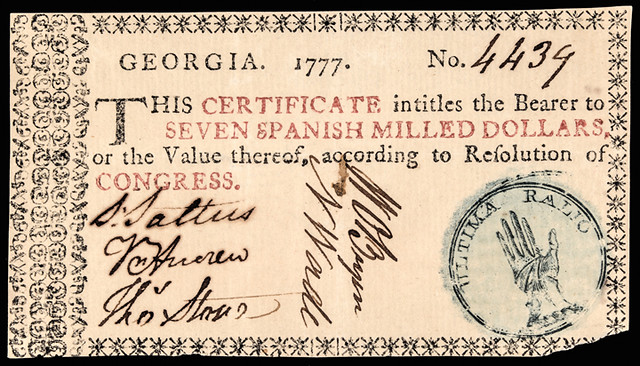
Georgia. 1777 Act. Seven Dollars. “Hand” Vignetted Seal. PCGS graded Extremely Fine-45.
Fr. GA-88. A classic 1777 Revolutionary War Georgia bold color Seal type. In the John J. Ford, Jr. / Ex-Boyd Auction Sale there were two such “Hand” Seal notes offered, which realized $9,200.00 and $6,325.00 respectively. This is the One of only Two “Hand” Seal examples we have catalogued and it is a beauty! The laid period paper quality is crisp with just some light folds from circulation. It has excellent printed border ornaments that are fully on the paper, but for a few at the slightly trimmed lower right corner, its holder comment, missing LR corner.
The “HAND” Seal is superb blue, well detailed, with great line flow within the Hand itself. The motto, “ULTIMA RADIO” is clear (note: this is an Error Printed Note, as the second word should be “RATIO”. This current example is printed such that the D appears like an L. The reverse is very clean, signatures include; Samuel Saltus, Benjamin Andrew, Thomas Stone, Nehemiah Wade and William O’Bryen. Notes on this 1777 Georgia series are wonderful and classic, yet the “HAND” is truly a special beauty in many respects. This vividly printed red and black with a vivid Seal making it a highlight for any Georgia Currency collection.
To read the complete lot description, see:
1777 Georgia $7 Fabulous Blue Ink “HAND” Vignette
Seal (https://www.earlyamerican.com/Auctions/ClientPages/lots.item.php?auction=7&customerid=3683&lot=27)
Lot 36: Paul Revere Engraved May 25, 1775
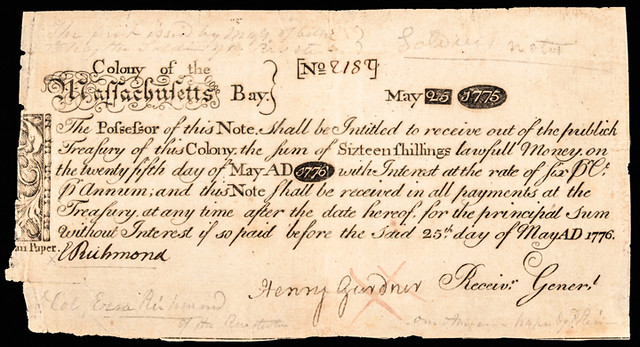
Colony of Massachusetts Bay. May 25, 1775 Indent Note. Sixteen Shillings. Copper Plate Engraved by Paul Revere. Due date of May 25, 1776. Genuine. PCGS graded Very Fine-30.
Fr. MA-146. An outstanding example of this very rare Revolutionary War period issue. All genuine Paul Revere Engraved Plate notes are important and the Indent series notes are particularly elusive, due to the fragile paper used and strong demand in commerce. This note has excellent overall eye appeal, exceptional full wide margins and handsome general appearance. Printed on “American Paper” only the “Americ” portion having being trimmed at the left indenture as issued. Printed on fine laid paper and having the manuscript signature of Henry Gardner very lightly canceled in red pen as Receiver General of the Colony.
Issued to pay 6% Interest per Annum. Most all of these notes were actually turned in and destroyed by the Treasury, having a printed one year life, only until May 5th of 1776, thus making any note of this issue exceedingly rare, particularly in such high quality. Holder states, apparent pen cancelled, restorations, minor mounting remnants and damage on back. Several light folds, traces of prior album mounting on the blank reverse ends, and the face eye appeal is superior and very sharp. Some old generation faint pencil notations on the face and sealed splits are hard to see and can be easily erased. A superior quality example of Paul Revere’s engraving, and a denomination missing in even the most specialized Colonial currency collections.
To read the complete lot description, see:
Paul Revere Engraved May 25, 1775 Mass. “Indent Note”
(https://www.earlyamerican.com/Auctions/ClientPages/lots.item.php?auction=7&lot=36)
Lot 207 : Three Cents Norris Encased Postage Stamp

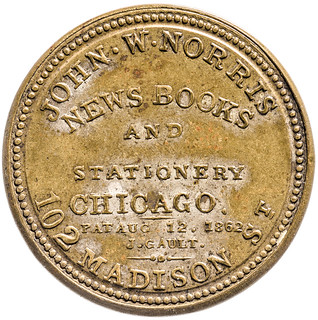
EP-52a, HB-185, S-137, Reed-NO03. Three Cents. JOHN W. NORRIS, NEWS-BOOKS & STATIONARY, Chicago, Choice Extremely Fine.
c. 1862 Civil War. Rated as Rarity-9 (2 to 4 known) according to Fred Reed. In “The Standard Catalogue of Encased Postage Stamps” Michael Hodder suggests that this 3¢ denomination is the rarest for this merchant, with less than three examples known, and now being two decades later, the consensus is at perhaps four exist. Two were sold as part of the historic Stack’s sale of the John J. Ford, Jr. Collection in June 2004. We sold one in our EAHA Auction of June 10, 2007 Lot 5265, graded Extremely Fine with mica problems, which sold for $5,074; plus another graded Extremely Fine+ on October 15, 2011 selling for $7,080.
This current example is a great rarity by all numismatic and philatelic standards. It is at least the equal in quality to our October 2011 auction lot. This current example also has scattered traces of original Silvering present within its reverse legends and is very well centered, with a clean red George Washington stamp. Its mica is solid having a tiny area of mica craze to the outer surface layer at the upper rim of the left obverse moon. The case itself is choice and fully original, having one trivial nick on its left moon, with a natural golden-chestnut color. A notation on a paper card insert has a pedigree and attribution notation to Richard Wolffer Stamp Auction of April 26, 1985. This is rarest of John W. Norris denominations and the very finest that we have ever offered.
Indeed a great rarity. The 1985 Wolffer sale is legendary. I was just beginning to collect encased postage at that time. I could only afford to bid on a handful of lots but would have liked to bid on nearly every one. -Editor
To read the complete lot description, see:
Three Cents JOHN W. NORRIS Chicago Rated Rarity-9
(https://www.earlyamerican.com/Auctions/ClientPages/lots.item.php?auction=7&lot=207)
Lot 224 : 1814 New York Six Cent Scrip Note

Salem, NY. Private Issuer. “I promise to pay at my Office”. 6 Cents. November 15, 1814. Backed. PCGS Very Good-8.
Haxby NY-Not Listed. Harris HXX. Extremely Rare scrip note backed on card, at least 95% compete. Imprint at bottom, Dodd, Rumsey & Stevenson’s Print Salem. Holder states apparent severed, splits and tears, backed. Signature faded. Boldly printed. Extremely Rare and absolutely missing in virtually all New York currency collections!
Six cents is a very odd and rare denomination. 6 1/4 cents is far more common for this era, equal to half a bit. -Editor
To read the complete lot description, see:
Rare Unlisted 1814 Haxby 6 Cent NY Scrip Note
(https://www.earlyamerican.com/Auctions/ClientPages/lots.item.php?auction=7&lot=224)
Lot 228 : Abrams Type “Hard Times” Satirical Note

Rare, Philadelphia Abrams Type “Hard Times” Satirical Note, Philadelphia, PA, Isaac Abrams 10¢ Capital Currency, Satirical Note, June 1, 1837, Choice Very Fine.
Haxby-Not listed. HT-N26B in Russ Rulau’s “Standard Catalog of United States Tokens, 1700-1900”. Signed by T. Young as Cashier and Issaac Abrams as President. This note refers to Nicholas Biddle, who was President of the ill-fated Bank of the United States. In May 1837, specie payments were suspended following a run on the banks. This resulted in massive shutdowns of factories, subsequent high unemployment, and freezing and starving during the winter of 1837-38.
This interesting note shows a group of Quakers protesting the street-preaching of a man named Abrams. There are at least three dates known of this type and these are quite scarce in high grade. This is superior to the Ford X Sale piece which eclipsed $1,000 with ease. Later, that note fetched $1,840.00 in the January 2010 Americana Sale.
To read the complete lot description, see:
Rare, Philadelphia Abrams Type “Hard Times” Satirical Note,
Philadelphia, PA, Isaac Abrams 10¢ Capital Currency, Satirical Note, June 1, 1837, Choice Very Fine.
(https://www.earlyamerican.com/Auctions/ClientPages/lots.item.php?auction=&lot=228)
Lot 239 : 1909 Macerated Currency Taft Plaque



1909-Dated Copyright, Macerated Currency Portrait Plaque of President William H. Taft (27th President of the United States from 1909–1913), Very Choice About Mint.
This exceedingly rare example of Political Commemorative Macerated Currency. It is round measures about 4” in diameter and 1/2” thick including the displayed extremely large central raised high relief Bust Portrait of President Taft, shown with an embossed scroll above from which dangles two short wreaths. With the partial punch located above the head at top for potential use in wearing on display, as it was made. Trivial flaws inherent to the manufacturing process and as made affect some of the highest points and are barely worthy of mention.
Overall, this specimen is virtually perfect and nearly as nice as on the day it was made. An original fully intact crisp label on the reverse reads: “Made of the U.S. Greenbacks redeemed and macerated by the U.S. Government at Washington, D.C. Estimated at $5,000.” The finest and only the second example of two we have ever offered, the first sold in our EAHA Auction of August 23, 2003, Lot 904, (which was not as nice in quality), which sold for $1,035. Now being a decade and a half later, another delightful opportunity for the specialists in this unusual collecting field.
An odd item of numismatic ephemera, but a great conversation piece. -Editor
To read the complete lot description, see:
1909 Macerated Currency President William H. Taft Plaque Extremely
Rare the Finest of Only Two We Have Offered (https://www.earlyamerican.com/Auctions/ClientPages/lots.item.php?auction=7&lot=239)
SELECTIONS FROM HOLABIRD JULY 2019 SALES
Here are some items that caught my eye in the upcoming Holabird sale. -Editor
Lot 2561 : Parsons Gold Ingot


Parsons Gold Ingot: "Parsons & Co. / Assayers/ Col. - 1860/ Twenty Dolls// CARAT DWT/ 18 1/2 25 6/10" rectangular, 1.2 x 0.75". 1.26 Troy Ozs.About twenty years ago, we published an article in Coin World "Ingots: The Good Bad and the Ugly". In this article we discussed finding four of these in our research of collections around the country, including one at the Smithsonian. I call these "the original four". We were able to run some tests on two of them as I recall, but at the time I never had a sample of placer gold from the historical source of where Parsons reportedly mined, which I would have used in comparative analogy. Other advanced technology was in its infancy.
This ingot came out of an old Colorado collection, but like the others, the ultimate provenance is completely unknown. Over the years, we were lucky and found an original map showing the locations of where Parsons worked, as shown on a previously unknown 1865 map of the district. Today, I'd love to go to the spot, get the gold myself, and make comparative tests with both ICP and SEM/EDS. But this is an academic pursuit of which funding would need to be secured, and life moves on....
Today, this ingot has been presented to us to sell, and for me to openly discuss my thoughts. During the course of research years ago, I found an 1880 reference to Parsons and his ingots, but no specifics were ever mentioned. I plowed through days of early Colorado newspapers looking for tidbits, but came up mostly empty. This I expected, because Parsons was in a very remote area far outside of the reporting area of the Denver newspaper in 1860. The big question is this: are all four ingots fakes?, or is one of the four an original, from which the others were copied? and if so, which one is real?
Two of the original four are in museums and their donation or purchase data shows acquisition after 1960, as I recall. There is no provenance on any of them, which makes it more difficult. But this is actually the norm- Historical ingots came out of the woodwork when Ford and Franklin worked the West in the 1970's. After the Gold Reserve Act was repealed in 1975, precious metal items came out like water, especially after gold and silver prices rose to new heights. People needed money, and out came their old gold and silver items, sold into the bullion market.
Many legitimate great pieces were "discovered". Then came the SSCA, which clearly showed the cultural influence on marking ingots over time, which helped all understand the assayer markings system better. One of my all-time favorites was getting a silver Knight assay ingot (Marysville) right from the family who had used it as a paperweight. I have little doubt that at least two of the "original four" Parsons ingots are fake. I have a very high confidence that the other two may be fake as well, based on comparative analogy of other known original ingots.
But it must be remembered that Parsons was not part of the California or eastern assay business, and he therefore had no prior knowledge of how assayers customarily marked their ingots. We also know, absolutely, that parts of the assayer business in Colorado developed differently from that in California and Nevada. This makes sense, because there was little or no crossover in assayers until the Denver Mint began their work. By the way, please don't forget that there is a real 1865 gold ingot from the Denver Mint at the Colorado Historical Society, complete with provenance to 1929, and I believe we closed the gap all the way back to 1865 with newspaper research. That ingot is marked in the "standard" manner, though the marking methods were dictated by the Mint system.
Can we prove absolutely that all four are fakes? No. Can we prove absolutely that one of the four is real? Someday, perhaps. The technology absolutely exists today to allow for detailed analysis that would help render an opinion, much of which I and we do all the time for unpublished project work. But it takes a budget.
To read the complete lot description, see:
Parsons Gold Ingot, One of the
"Original Four" (108011) (https://holabirdamericana.liveauctiongroup.com/Parsons-Gold-Ingot-One-of-the-Original-Four-108011_i33667968)
Lot 2571 : Numismatic and Antiquarian Society of Philadelphia Medal

Formed in 1857, the Numismatic and Antiquarian Society of Philadelphia (NAS) was a non-profit organization “dedicated to the encouragement and promotion of numismatic science and antiquarian research.” Important members of the organization included William S. Vaux, Joseph J. Mickley, Henry P. McIlhenny, Dr. D. G. Brinton and Eli Kirk Price. Meetings were often held in the homes of members, where coins and medals were displayed and papers on a variety of subjects, including the transition from wooden sailing vessels to steel steamships, the collections of the Union League, Chinese export porcelain, and paper making at Ivy Mills, were read. This bronze medal is 41 mm, featuring Eli K. Price, President on the obverse; and the society's seal on the reverse. Salvatore Falcone Collection
To read the complete lot description, see:
Numismatic and Antiquarian
Society of Philadelphia Medal (108121)
(https://holabirdamericana.liveauctiongroup.com/Numismatic-and-Antiquarian-Society-of-Philadelphia-Medal-108121_i33667978)
Lot 3637: Argenta Stock Certificate
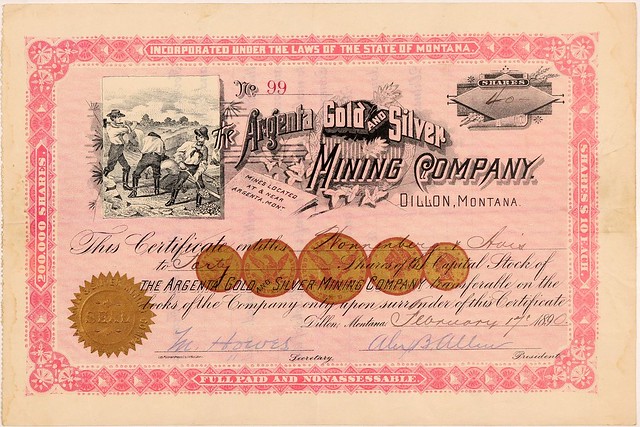
Wow! Mines located at & near Argenta, Mont. (printed under title). Inc. in Montana. No. 99, issued for 40 shares to Wonnenberg & Avis on Fed. 17th, 1890 in Dillon, Montana. Signed by president Alex. Allen and secretary Howes. Not cancelled. Very attractive design with black print, pink border and background, mining vignette, and five gold foil vignettes of US gold coins! Printed by Pioneer Press, St. Paul. Pinholes, folds. 6.25 x 9.25" The Argenta Mining District was located in Beaverhead County. This company appears to have been in a lawsuit with the PJ Kelly Placer & Quartz Mining & Reduction Company about disputes of property. Ken Prag Collection
Date: 1890
State/Country: Montana
City/County: Argenta
To read the complete lot description, see:
Argenta Gold & Silver Mining Co.
Stock Certificate (104418) (https://holabirdamericana.liveauctiongroup.com/Argenta-Gold-Silver-Mining-Co-Stock-Certificate-104418_i33668717)
Lot 6049 : Space Medals
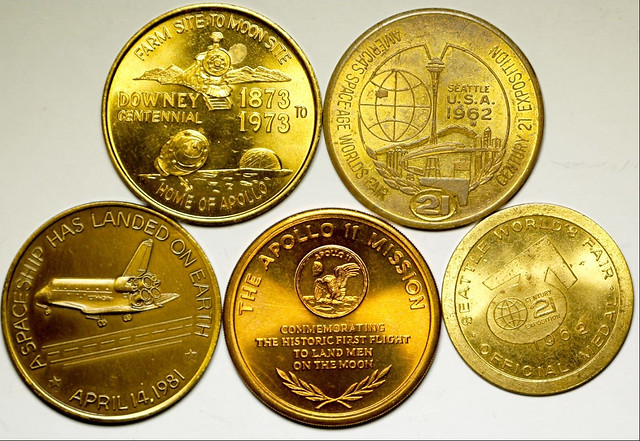
Lot of five: Apollo 11 Mission (copper); Space Shuttle 1981; Seattle World's Fair 1962 (2); City of Downey, Home of Apollo "farm site to moon site".
To read the complete lot description, see:
Space Medals (75143)
(https://holabirdamericana.liveauctiongroup.com/Space-Medals-75143_i33670786)
Lot 6180 : Southern Pacific Railroad Medal

Obv.: Southern Pacific / Lines in Oregon / Company; rev.: For / Best / Section. White metal, 27 mm, with loop.
To read the complete lot description, see:
Southern Pacific Railroad Medal (105241)
(https://holabirdamericana.liveauctiongroup.com/Southern-Pacific-Railroad-Medal-105241_i33670917)
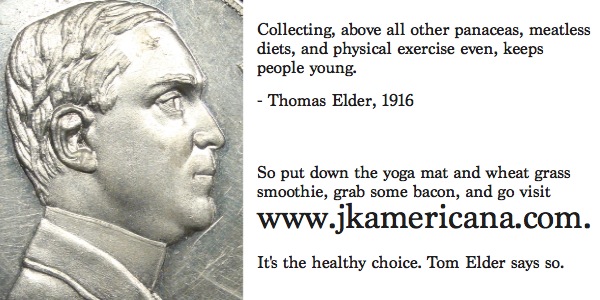
THEODOSIUS II SOLIDUS FOUND BY ISRAELI STUDENTS
Found via The Explorator Newsletter is this article on a gold solidus discovered by Israeli students. -Editor


A rare gold solidus dating back 1,600 years has been found by a group of Israeli students in the Galilee region.
“The gold coin is a solidus minted by the emperor Theodosius II in Constantinople around 420-423 CE,” said Dr. Gabriela Bijovsky, a numismatic expert at the Israel Antiquities Authority (IAA).
“Similar coins are known from the Eastern Byzantine empire, but this is the first of its type discovered in Israel.”
“One side depicts the image of the emperor and the other shows the image of the Goddess Victory holding the Staff of the Cross.”
“It is symbolic that the gold coin discovered adjacent to the Sanhedrin trail reflects the period of dramatic events when the Sanhedrin ceased to function in the Galilee, and the center of Jewish life transferred from the Galilee to Babylon.”
To read the complete article, see:
Rare Byzantine Gold Coin Found in Israel
(http://www.sci-news.com/archaeology/byzantine-gold-coin-israel-07350.html)
SWIPING THE MILLION-DOLLAR GOLD COIN
Harvey Stack writes:
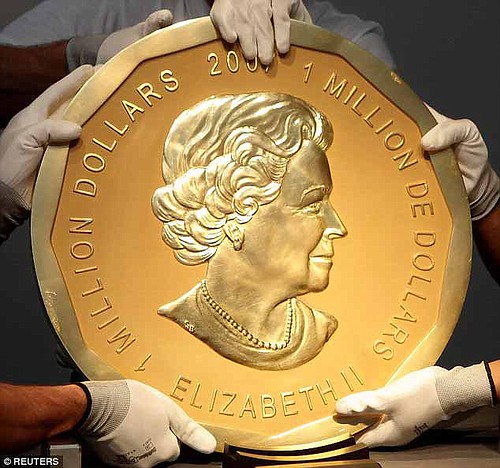 I suggest readers get a copy of the
Bloomberg Businessweek July 1, 2019 issue and see the "heist story" and cartoon on Page 46 and on, about the great $1 million Maple Leaf Heist
which occurred on March 27,2017
I suggest readers get a copy of the
Bloomberg Businessweek July 1, 2019 issue and see the "heist story" and cartoon on Page 46 and on, about the great $1 million Maple Leaf Heist
which occurred on March 27,2017
It is done in a narrative and cartoon form, and is quite A story about this great robbery. A 220 pound maple leaf, at the time made of 1 million dollars pure gold was stolen from a Berlin museum.
Thanks, Harvey. The feature is also available online at the link below. -Editor

In 2007 the Royal Canadian Mint had a wild idea—create the world’s first million-dollar coin. It would be 99.999% pure gold, 220 pounds, and as tall as a car tire. Five so-called Big Maple Leaf coins were purchased by investors.
In 2010 a private collector in Düsseldorf loaned his Big Maple Leaf coin to Berlin’s Bode Museum.
Curators placed it behind bulletproof glass in the middle of Room 243, where the Bode keeps some of its most valuable coins.
It sat there for seven years.
The entire break-in took only 16 minutes.
To read the complete article, see:
It Took Only 16 Minutes
for Thieves to Swipe a Million-Dollar Gold Coin
(https://www.bloomberg.com/news/features/2019-06-28/it-took-only-16-minutes-for-thieves-to-swipe-a-million-dollar-gold-coin)
To read earlier E-Sylum articles, see:
GIANT GOLD MAPLE LEAF COIN STOLEN (https://www.coinbooks.org/v20/esylum_v20n14a11.html)
ARRESTS MADE IN THEFT OF BIG MAPLE LEAF (https://www.coinbooks.org/v20/esylum_v20n29a08.html)
GIANT COIN THEFT FAMILY PROPERTIES SEIZED
(https://www.coinbooks.org/v21/esylum_v21n29a37.html)
Readers may enjoy another article in the same issue about a great model train heist in England. -Editor
These model trains often require decades to build and are considered priceless by their owners. At market, they can fetch tens of thousands of pounds. And though they’re small, one-twelfth the scale of a normal train, they’re not that small. The locomotives—which burn model-train-size bricks of coal, carried in model-train-scale tenders and fed with tiny shovels—weigh hundreds of pounds each. They’re powerful enough to pull eight children, who ride, straddling passenger cars, around a special narrow-gauge track at 8 mph.
The burglars scoured the grounds, which belong, along with the locomotives, to members of the Gravesend Model Marine & Engineering Society (GMMES), a 66-year-old British railway club. They found a hoist, a wheelbarrow, and a set of the club’s walkie-talkies.
To read the complete article, see:
The Great Model Train Robbery
(https://www.bloomberg.com/news/features/2019-06-28/britain-s-great-model-train-robbery-remains-an-unsolved-crime)
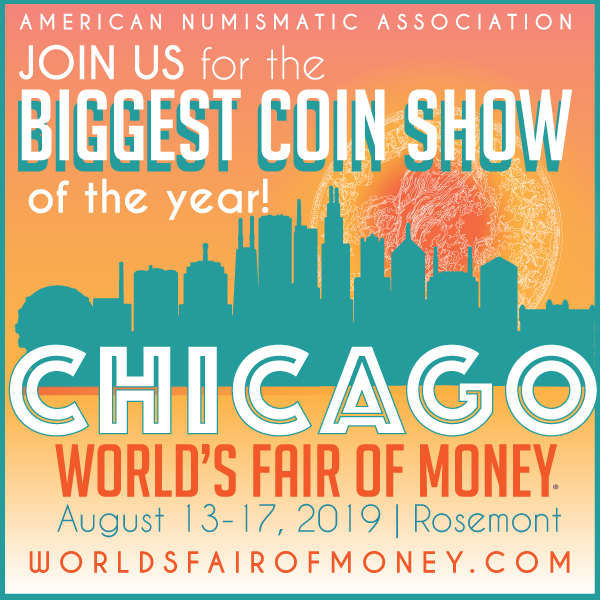
NEW NICARAGUAN POLYMER BANKNOTES
A July 1, 2019 Coin Update article by Michael Alexander discusses Michael Alexander new Nicaraguan polymer banknotes. -Editor
The Banco Central de Nicaragua has announced (24th June) they will shortly be issuing new versions of the 500 and 1,000-cordoba (U.S. $30.00) banknotes that will be printed on a polymer substrate. These notes were initially introduced in 2017 as paper-printed banknotes and as part of a revision and update of security features. They will now be printed on polymer.
The new directive to begin production of banknotes printed on polymer was originally approved in 2015 with the first notes being issued that same year. Denominations of 10, 20, 50, 100, and 200 cordobas were released in October 2015. The directive to transition the two highest denominations was approved by the Board of Directors of the Banco Central in October 2017. The directive sought to strengthen the quality and security of the banknotes taking into account the advances in printing technologies, supply public demand for high-denomination banknotes, and replace those current notes that are removed from circulation due to their deterioration.

500 cordobas, red: 156 by 67 millimetres. On the face is shown the Cathedral of Leon. A significantly important and historic landmark in Nicaragua, the cathedral was awarded World Heritage Site status with UNESCO, and, as such, it is Nicaragua’s third cultural landmark. On the back is an image of Momotombo, a composite volcano in Nicaragua near the city of León. It stands on the shores of Lago de Managua. The ruins of this city are preserved at León Viejo (Old León).

1,000 cordobas, green: 161 by 67 millimetres. Depicted on the face is an image of the Hacienda San Jacinto, the site where the battle of San Jacinto was fought on the 14th September 1856 between a group of 160 Nicaraguan Army soldiers commanded by Colonel José Dolores Estrada Vado (1792–1869) against 300 American roughriders of William Walker (1824-1860) one-time founder of the failed Republic of Sonora. The back includes an illustration of the Castle of the Immaculate Conception on the banks of the Río San Juan. The castle is a fortification located on the southern bank of the San Juan River, in the village of El Castillo in Southern Nicaragua. The fortress is on a list of sites which is scheduled to achieve World Heritage Site status with UNESCO.
To read the complete article, see:
Nicaragua: New polymer 500 and 1,000-cordoba
banknotes to be released (http://news.coinupdate.com/nicaragua-new-polymer-500-and-1000-cordoba-banknotes-to-be-released/)
WEST AFRICAN STATES SEEK COMMON CURRENCY
Howard Berlin forwarded this article about a desire among West African states to create a common currency. -Editor

In the Nigerian capital of Abuja, heads of state from the Economic Community of West African States (ECOWAS) on Saturday confirmed their intent to create a common currency called the eco.
New ECOWAS head and Niger's president, Mahamadou Issoufou, stressed the importance of sticking to the roadmap to introduce the new currency, but there is still a significant amount of work to do if people are going to be spending ecos in 2020 as planned.
The proposed new common currency appears to have found the most support among Francophone countries where the CFA is in circulation. There have been many protests in Senegal and Benin against the CFA franc, which is pegged to the euro.
CFA critics, especially in Togo, see the new West African currency as a way to break free of financial dependence on former colonial power France.
In Mali, Etienne Fakaba, an economist and the director of the Center for Political, Economic and Social Research, is also a proponent of the eco. He said there are benefits in broadening the ECOWAS market.
A single currency, he said, would lead to savings across the board when it comes to exchange rates and promote unity.
"Ultimately, we will grow together into a stronger entity, including on the economic level," Fakaba said.
The economist added that a political plan will be required to make the eco a stable currency. "That way the sphere of influence can be extended," he said.
There is far less enthusiasm for the new currency in Nigeria — the most populated country in West Africa with around 200 million people. Even in the week before the summit, the subject was not one of public debate.
The question also arises as to whether Nigeria would ever commit to paying the national debt of neighboring states such as Benin, Togo and possibly Ivory Coast.
To read the complete article, see:
Common currency divides West African nations
(https://www.dw.com/en/common-currency-divides-west-african-nations/a-49422357)
KID COUNTERFEITERS?
Counterfeiting is an age-old problem, one that law enforcement combats constantly. I see dozens of media reports daily and few are notable enough to mention. Rare is the capture of a serious maker of high-quality counterfeits in quantity. Most incidents are run-of-the-mill poor homemade fake bills, or these days, fake "practice notes" or "movie money" bought online.
This Washington Post article discusses a recent incident at an elementary school. This case involved "play money" brought to school by one student that another student attempted to spend. -Editor
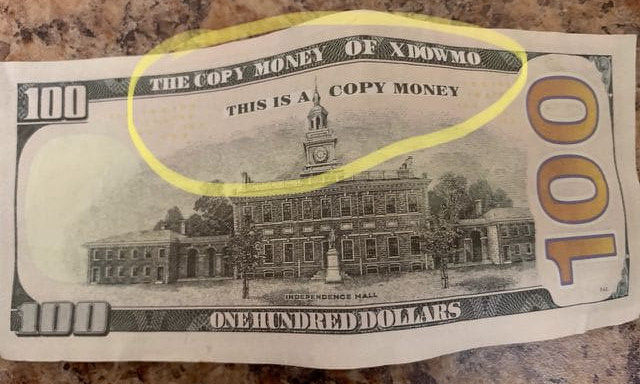
The trouble started after one second-grader gave another some of the play money she had brought to her suburban Maryland school. The classmate tried to use it — a mock $100 bill — for lunch in the cafeteria, and before long, school security was involved. Then the Prince George’s County police were called.
Then, the U.S. Secret Service.
“They treated it like a counterfeit scheme,” said Tamara McKinney, grandmother of the girl, then 7 years old, who brought in the bills, which were realistic but clearly marked “fashion prop money,” “copy money” and “the copy money shop of XDOWMO.”
Attempting to pass fake notes is a crime, and we can't expect authorities to look the other way, even when the shover is a second grader. The incident has to be investigated, and no one in this case was sent to the slammer. But parents are understandably concerned about elevating schoolyard incidents to the level of a federal investigation. -Editor
In Maryland, police involvement at elementary schools has also become a flash point in Montgomery County, where an incident involving play money led to a call to law enforcement on May 14.
In that case, a 10-year-old with learning disabilities shared mock $100 bills with friends on his school bus, and later a bus driver found a stray bill. The driver told a supervisor, and police were summoned; the child was identified through a bus camera video recording, authorities say.
Soon, a county police officer was at the boy’s elementary school, questioning him. The Secret Service — which deals with reports of counterfeit money — was notified.
“Outrageous,” the boy’s mother, Tiffany Kelly, wrote in an online petition, asking why a call was made to law enforcement, rather than “a call to mom.”
School officials are working to improve their protocols. Should it matter how lifelike the copies are? I put "play money" in quotes because today's cheap, high quality printing technology makes even notes clearly labeled as "play money" or "copy money" awfully real-looking at first glance. These notes were bought online by the girl's older brothers. The school reported that a student attempted to spend "counterfeit" money. Should they call it "play money"? Should they call authorities at all? -Editor
In Prince George’s County, school system officials said police got involved at Catherine T. Reed Elementary School in Lanham — where the second-graders had the play money — because of the way administrators reported the incident to school security offices: They called the money “counterfeit.” Security personnel called police.
Jennifer Donelan, a county police spokeswoman, said police investigated and notified the Secret Service, as is protocol with possible counterfeit money. But the children were not arrested or questioned.
Perhaps some future researcher will compile a catalog of these things. -Editor
To read the complete article, see:
The money was fake. The police were real. It happened in an elementary school.
(https://www.washingtonpost.com/local/education/the-money-was-fake-the-police-were-real-it-happened-in-an-elementary-school/2019/07/05/c2652b5c-704a-11e9-9f06-5fc2ee80027a_story.html)
LOOSE CHANGE: JULY 7, 2019
Here are some additional items in the media this week that may be of interest. -Editor
Wisconsin Metal Detectorists
This article from the Fond du Lac Reporter discusses local metal detecting fans and their coin finds. -Editor
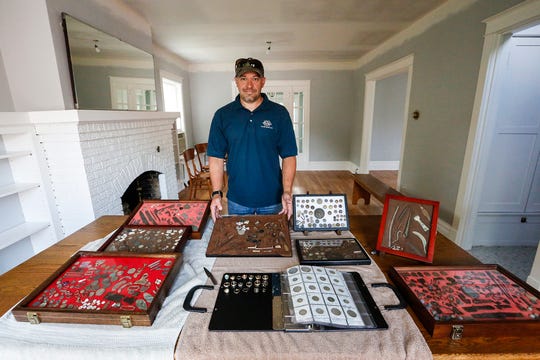
John Ruth's Medal Detecting Finds
The hunt for treasure is captivating and making a comeback around the country, Ruth said. Enthusiasts are drawn to the surprise of the prize – things like old coins, lost jewelry, historical artifacts. Even something as simple as an old wheat penny can be a thrill for a newcomer to uncover.
“It gets me outside and exploring on road trips with my friends or the kids," Ruth said. "All you really need is some good weather and a spirit of adventure."
Ruth's dad, John Ruth Sr., still lives up in Menominee. In his 50 years of detecting, he's uncovered 50,000 coins — about $4,000 worth. (He keeps a fastidious spreadsheet.) But that's not the best part of the hobby, he says.
To read the complete article, see:
You probably think these people with
metal detectors are wasting their time, but in Wisconsin, they've found some historic treasures
(https://www.fdlreporter.com/story/news/2019/07/03/fond-du-lac-man-unearths-history-metal-detector/1460883001/)
A discussion on the CoinTalk forum illustrates several fake coins in real and fake slabs. As always, buyer beware! -Editor
To read the complete discussion, see:
A fake coin in a genuine PCGS holder?
(https://www.cointalk.com/threads/a-fake-coin-in-a-genuine-pcgs-holder.341711/)
CoinsWeekly Seeks Full-Time Numismatist
Speak both English and German? Love to travel? The CoinsWeekly team is looking to expand. -Editor
To read the complete article, see:
Numismatist, Numismatischer Pressedienst Kampmann,
Lörrach (Germany) (https://coinsweekly.com/stellenmarkt/numismatist-numismatischer-pressedienst-kampmann-loerrach-d/)
$100 BILL TOOTHPICK TRICK
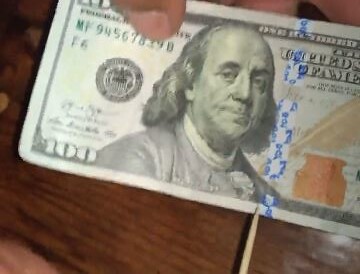
I wasn't terribly impressed, but some of you might want to check out this toothpick trick with a $100 bill. -Editor
All you need is your buddy Ben Franklin and a toothpick.
To read the complete article, see:
Vaguely Impress Your Friends With This $100 Bill Trick
(http://digg.com/video/100-bill-toothpick-trick)
FEATURED WEB SITE: NAVONA NUMISMATICS
This week's Featured Web Site is the blog of Navona Numismatics, featuring World War II-era currency, scrip, etc., especially occupation issues. Found via News & Notes for July 2, 2019, a publication of the Society for Paper Money Collectors.

http://navonanumis.blogspot.com/


